Transitional living rooms strike a perfect balance between classic elegance and contemporary style, creating spaces that feel timeless yet refreshingly modern. This design approach blends the best of both worlds, offering a versatile canvas that adapts to different tastes and trends. With the right combination of traditional elements and sleek, modern touches, a transitional living room becomes more than just a space—it's a statement of sophistication and comfort. These 40 stylish transitional living room ideas will inspire you to craft a space that exudes warmth, elegance, and effortless style.
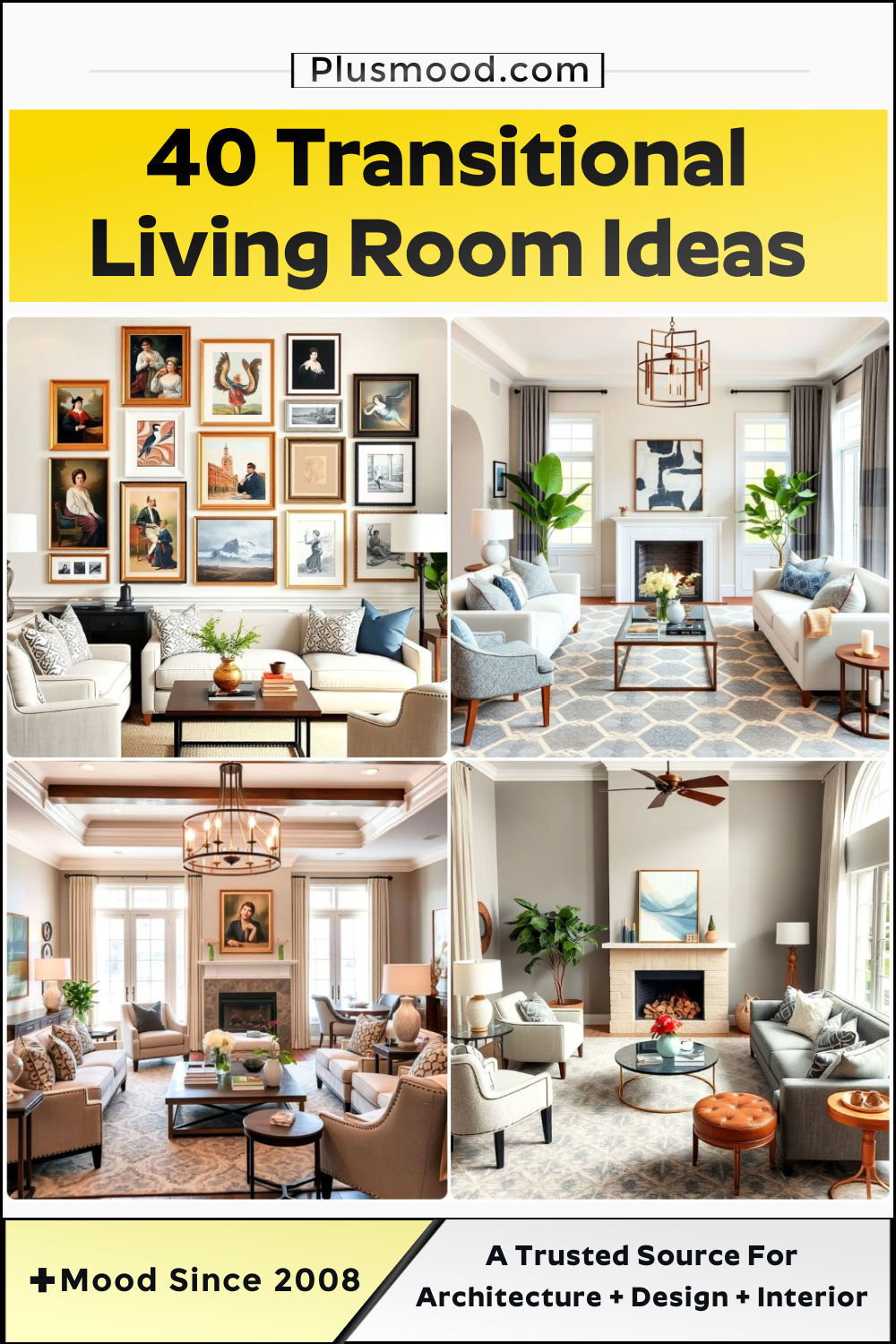
1. Blending Traditional and Modern Furniture

Incorporate a mix of classic and contemporary furniture inspired by modern living room ideas to create a cohesive look that exudes both elegance and comfort. Pairing a sleek, modern sofa with a traditional coffee table, for example, brings a balanced feel to the room. This blend of styles allows for versatility, making it easier to update the room's decor over time. By combining elements from different eras, you add character and create a space that feels both timeless and fresh.
2. Neutral Color Palette
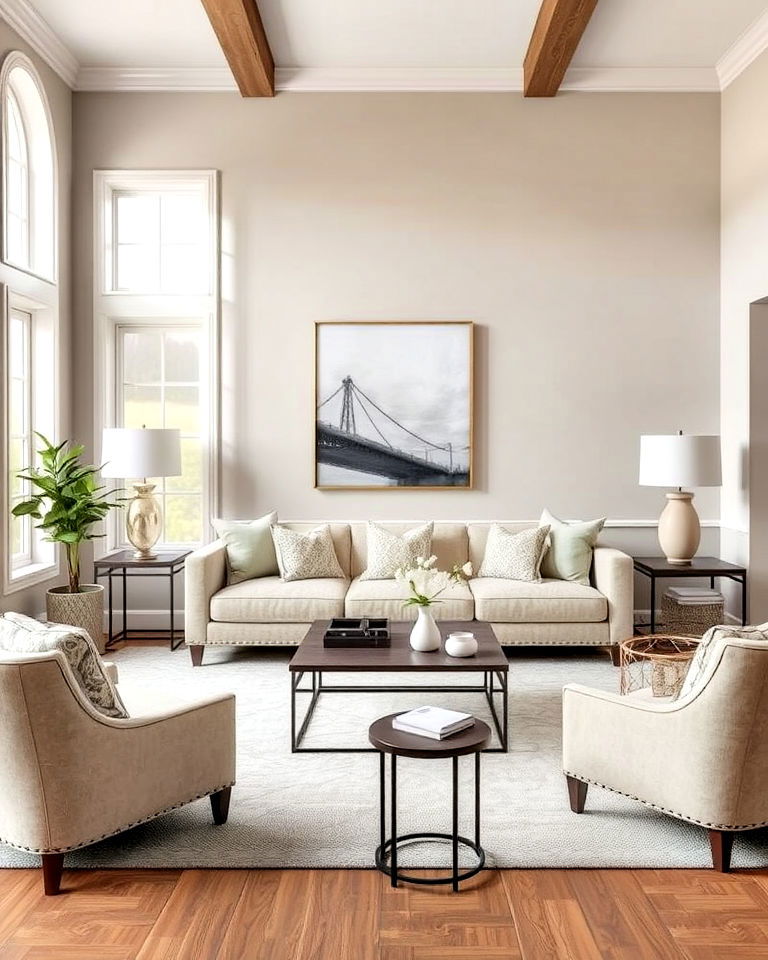
Using neutral living room ideas as inspiration, you can create the groundwork for a sophisticated yet serene atmosphere in a transitional space. Shades like beige, gray, and taupe provide a soft backdrop that highlights the room's features without overwhelming the space. Neutral tones also make it easy to introduce pops of color through accessories like throw pillows or artwork. This subtle approach to color ensures the room remains versatile and adaptable to different design trends.
3. Statement Lighting Fixtures

Explore elegant transitional living room ideas that blend classic and contemporary styles seamlessly. Elevate your living room's design with a statement lighting fixture that acts as both a functional piece and a focal point. A chandelier or bold pendant light, often seen in modern bedroom ideas, can draw the eye upward, enhancing the room's dimension. Besides enhancing the ambiance, living room wall lighting ideas help blend traditional and contemporary elements, reinforcing the transitional style. The right lighting choice can make a significant impact on the overall mood and character of the room.
4. Layered Textures
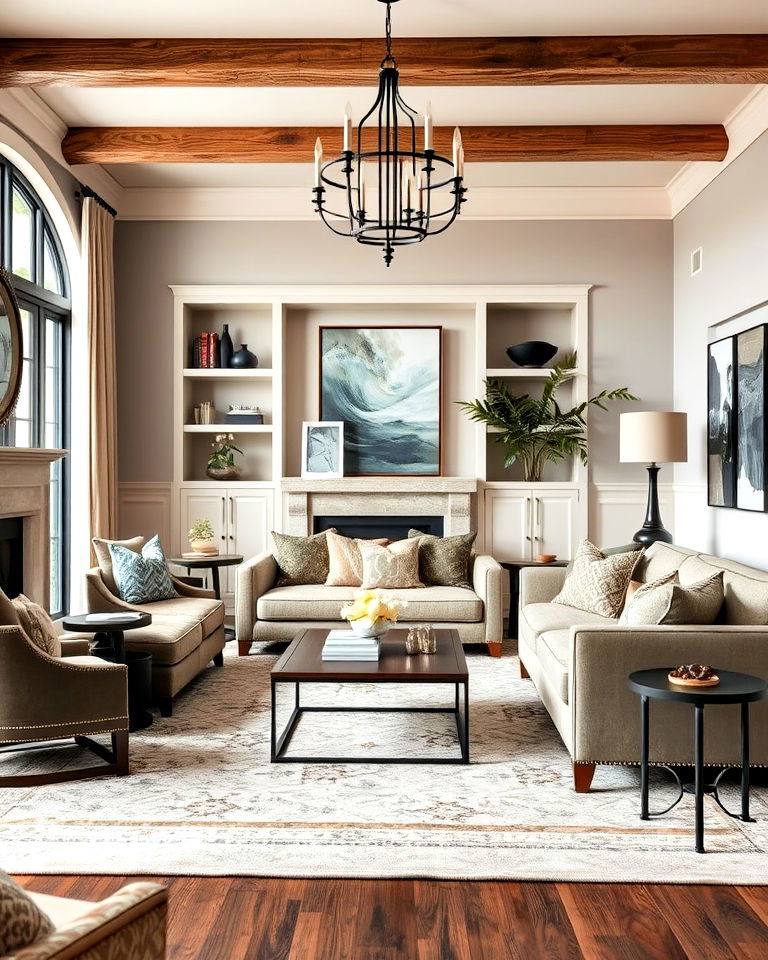
Incorporating layered textures is key to creating depth and warmth in a transitional living room. Combine materials like velvet, linen, and leather through furniture, throw pillows, and rugs to achieve a rich, tactile experience. The mix of soft and hard textures not only adds interest but also enhances the comfort of the space. This approach makes the room feel inviting and luxurious, striking the perfect balance between formal and casual elements.
5. Classic Artwork with a Modern Twist
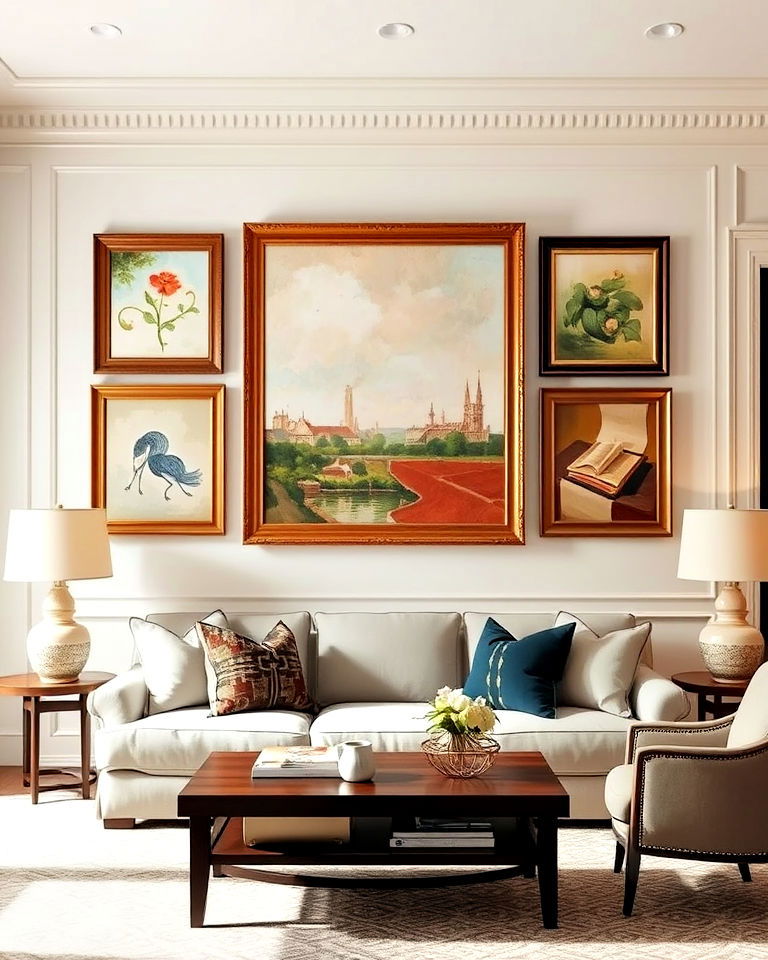
Adorning your walls with living room wall decor ideas, such as classic artwork with a modern twist, can bring a unique flair to your space. Look for traditional pieces reimagined with contemporary colors or abstract details to bridge the gap between past and present. This art style complements the transitional theme by blending old-world charm with a fresh perspective. Displaying such artwork can also become a conversation starter, enriching the visual appeal of your space.
6. Minimalist Approach to Decor
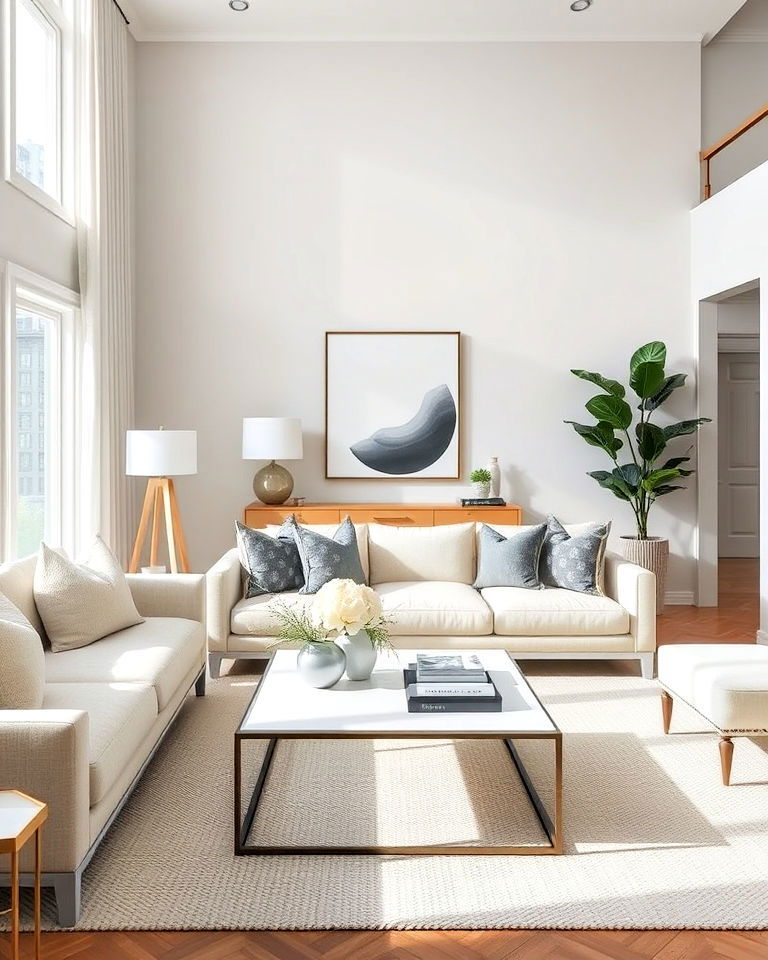
A minimalist approach to decor can keep your transitional living room feeling uncluttered and elegant. Focus on a few key pieces that showcase quality and style, such as a sleek coffee table or a sculptural vase. This strategy helps maintain a clean, sophisticated look while allowing the room's design elements to stand out. By avoiding excess decorations, you create a space that feels open and airy, enhancing both comfort and aesthetic appeal.
7. Use of Symmetry
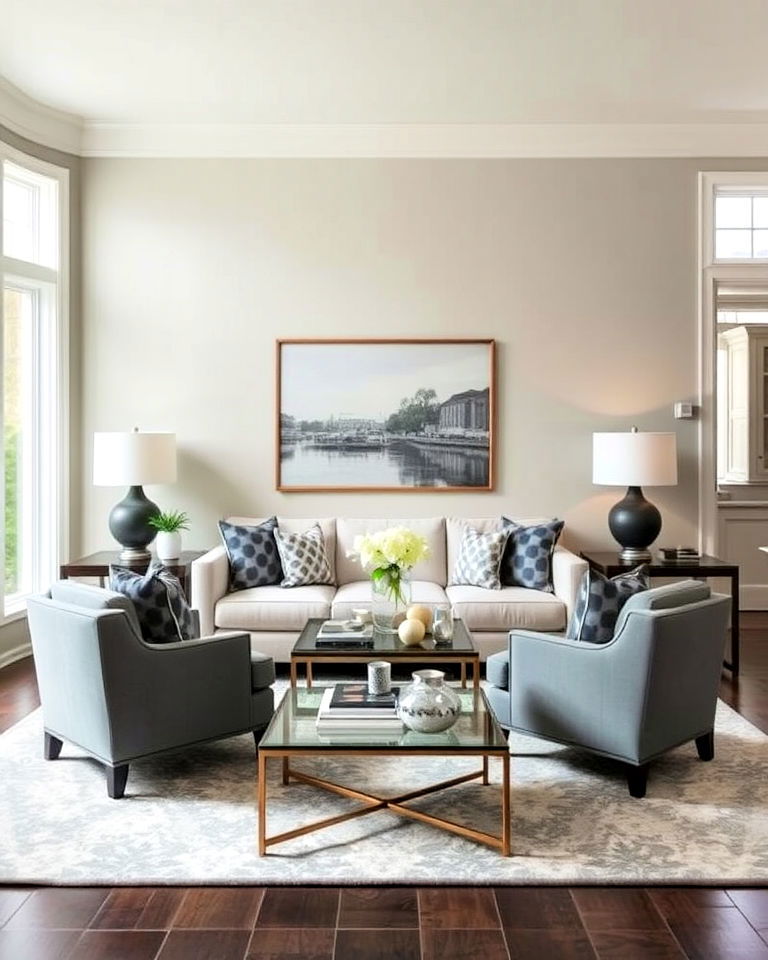
Employing symmetrical living room layouts adds a sense of order and harmony that is pleasing to the eye and balances the space effortlessly. Place matching chairs or lamps on either side of a sofa to create a balanced look that feels both structured and welcoming. Symmetry is a hallmark of transitional design, offering a way to seamlessly blend traditional and contemporary pieces. This method not only brings visual stability but also makes the space feel more thoughtfully designed.
8. Incorporating Natural Elements
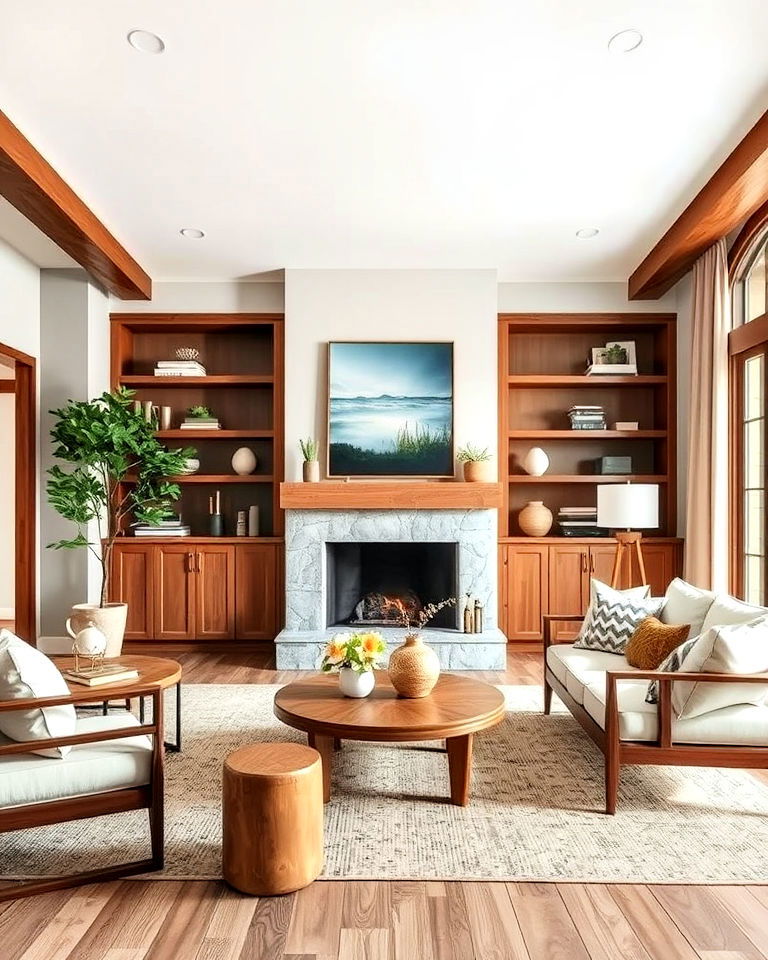
Bringing natural elements into your transitional living room design can create a more inviting and grounded atmosphere. Incorporate wooden furniture, stone accents, or indoor plants to add warmth and a touch of nature. These elements complement both traditional and modern aesthetics, making them perfect for a space that bridges two styles. Natural materials also enhance the room's texture and visual appeal, making it feel both cozy and sophisticated.
9. Multi-Functional Furniture
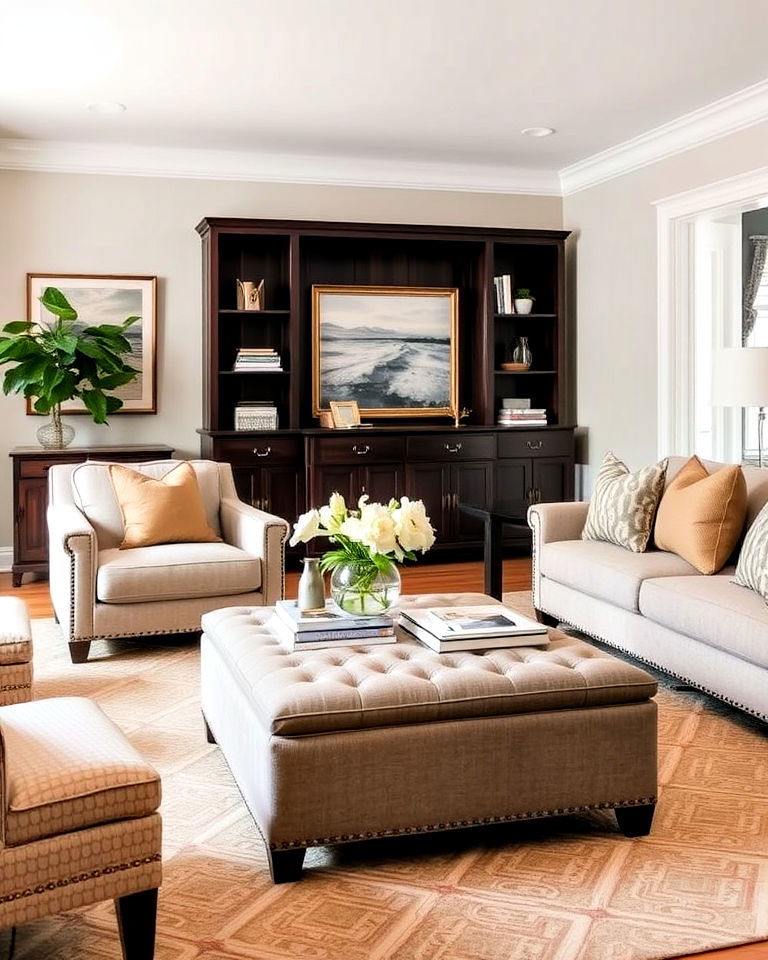
Discover the beauty of a transitional-style living room with timeless charm and modern touches. Incorporating multi-functional furniture is a smart way to maximize both style and utility in a transitional living room. Choose pieces like ottomans with hidden storage or coffee tables that can double as workspaces. This approach helps keep the room clutter-free while maintaining its elegant appeal. Multi-functional items also make it easier to adapt the space to different needs, ensuring that your living room remains both beautiful and practical.
10. Bold Accent Wall
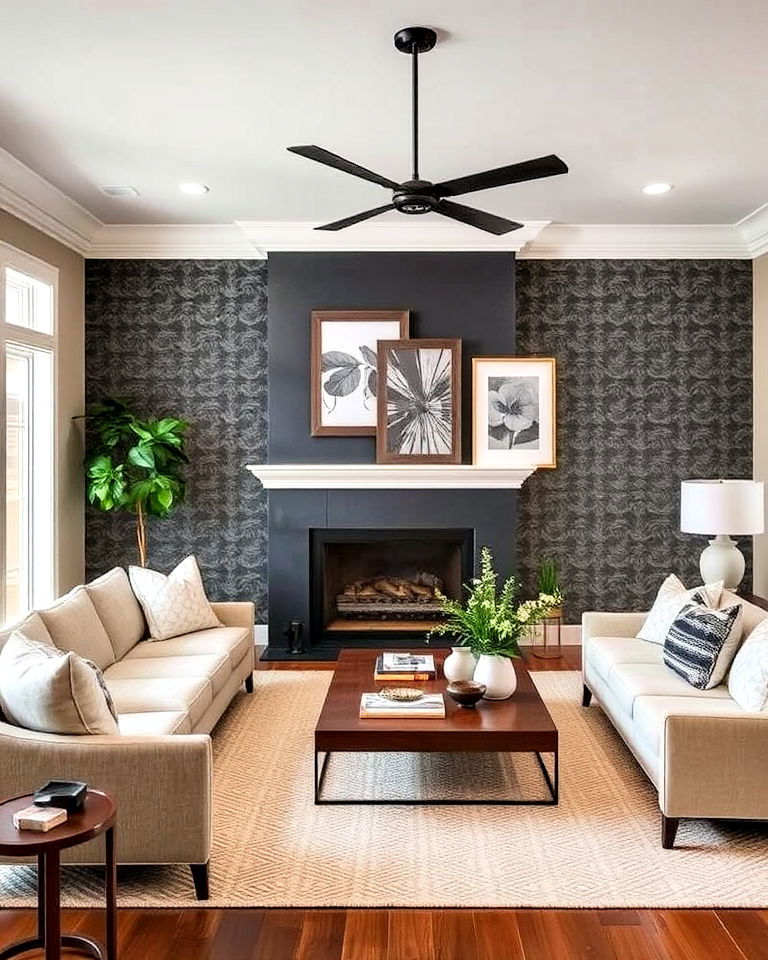
Creating a bold accent wall is an excellent way to incorporate living room accent wall ideas and add a dramatic touch to a transitional space. Whether you use a striking paint color, textured wallpaper, or wood paneling, an accent wall can become the focal point of the space. This feature adds depth and personality without overwhelming the room's overall neutral palette. A well-chosen accent wall enhances the transitional theme by adding a modern element to a classic setting.
11. Elegant Drapery
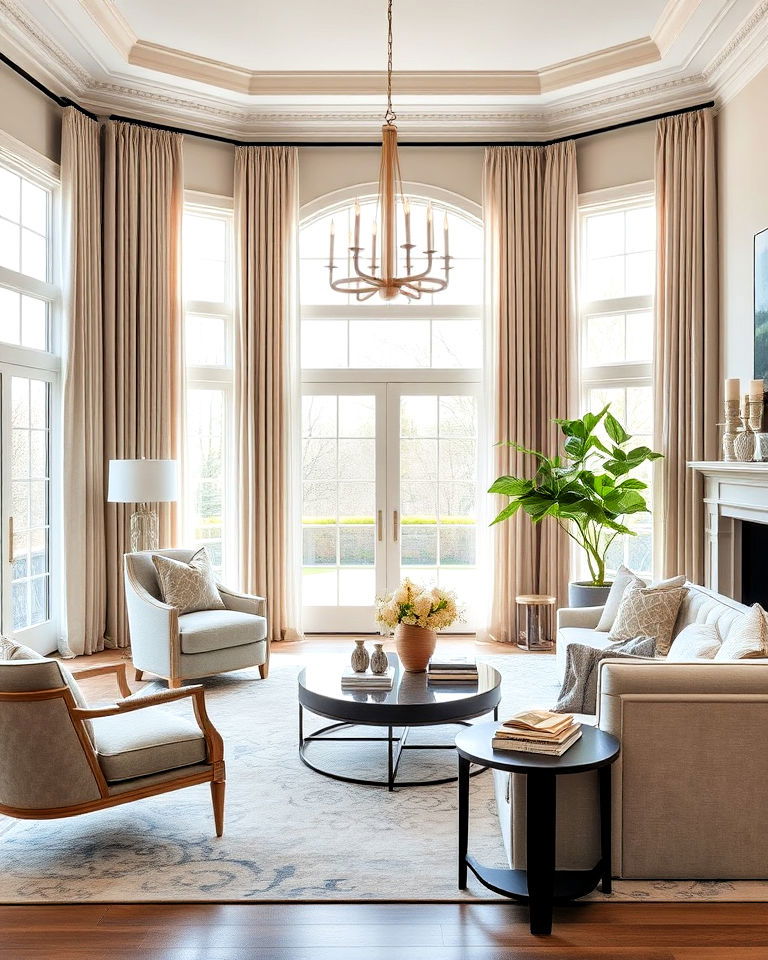
Elevate the look of your living room with elegant drapery that adds both style and function. Opt for floor-to-ceiling curtains in luxurious fabrics like silk or velvet to create a sense of height and grandeur. Drapery not only frames your windows beautifully but also enhances the room's overall texture. In a transitional space, this choice ties together traditional and contemporary aesthetics, adding a touch of softness and sophistication.
12. Incorporating Metallic Accents
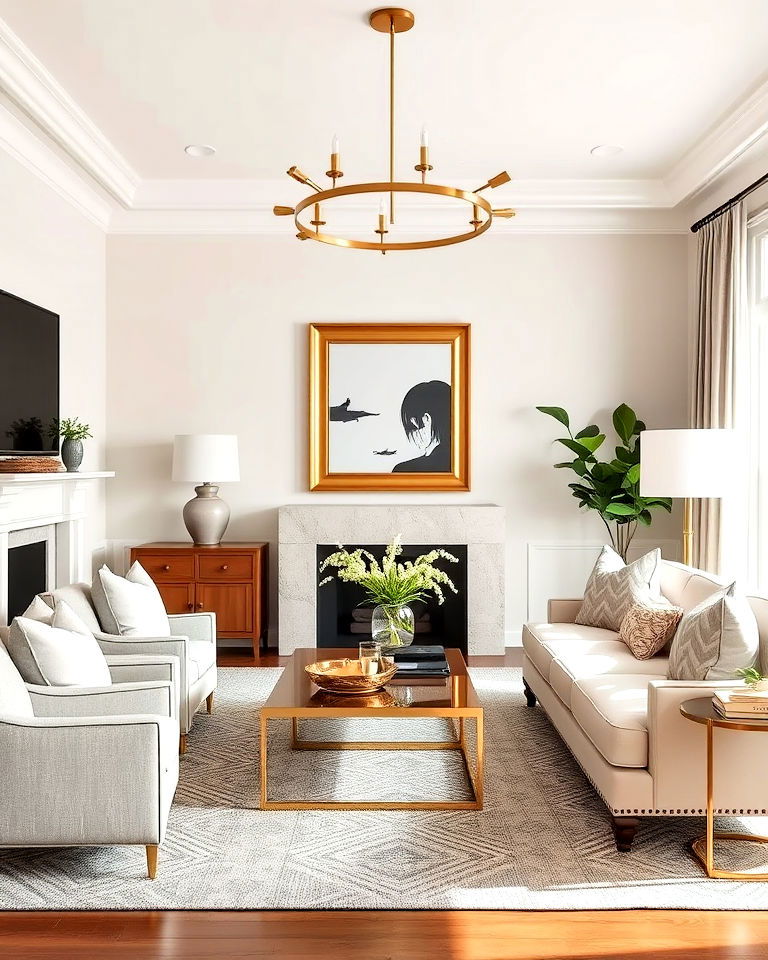
Metallic accents can add a touch of glamour and refinement to a transitional living room. Choose elements like brass, gold, or chrome in light fixtures, picture frames, or side tables for a hint of luxury. These metallic details catch the light and create a sense of depth and elegance in the space. Blending these accents with softer textures and neutral colors helps to balance the room, making it feel cohesive and well-designed.
13. Open Floor Plan Integration

If your living room is part of an open floor plan, consider a seamless design that integrates with adjoining spaces. Use area rugs, furniture arrangements, or color schemes to define the living area while maintaining a cohesive look with the rest of the home. An open floor plan enhances the flow of natural light and air, making the living space feel larger and more inviting. This setup perfectly complements the transitional style by merging different areas harmoniously.
14. Classic Patterns with a Twist
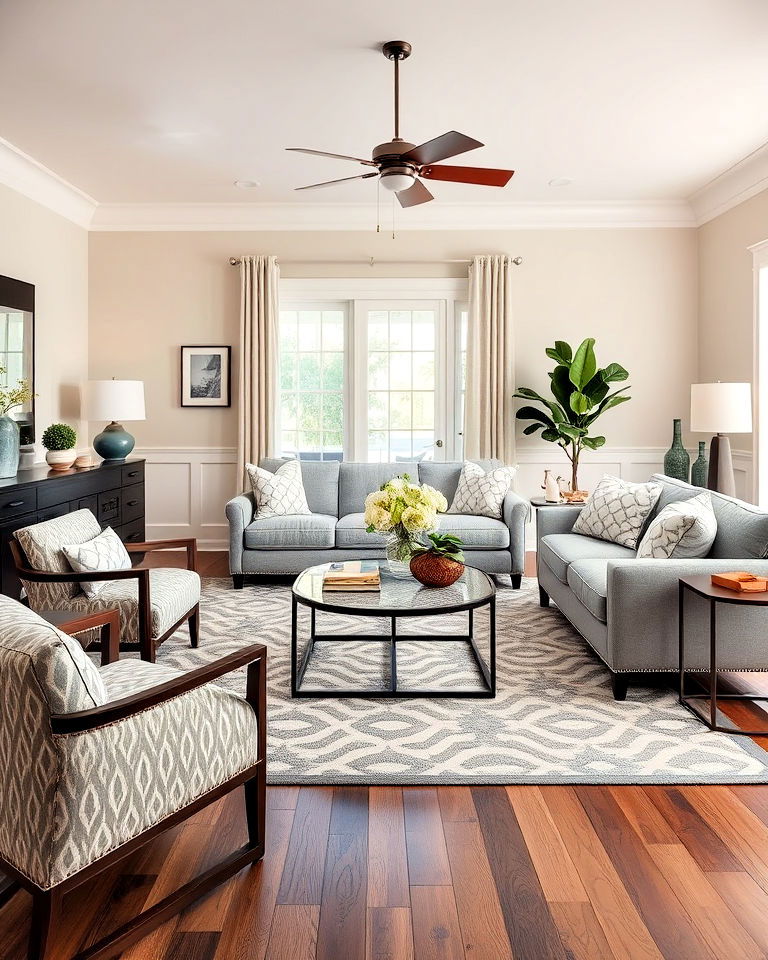
Incorporating classic patterns with a modern twist can elevate the style of a transitional living room. Consider using geometric or floral designs on rugs, throw pillows, or upholstery, but with updated colors or abstract shapes. This combination bridges the gap between traditional and contemporary elements, adding visual interest without overpowering the room. Classic patterns reimagined in fresh ways can give your living space a timeless yet current feel.
15. Cozy Fireplace Focus
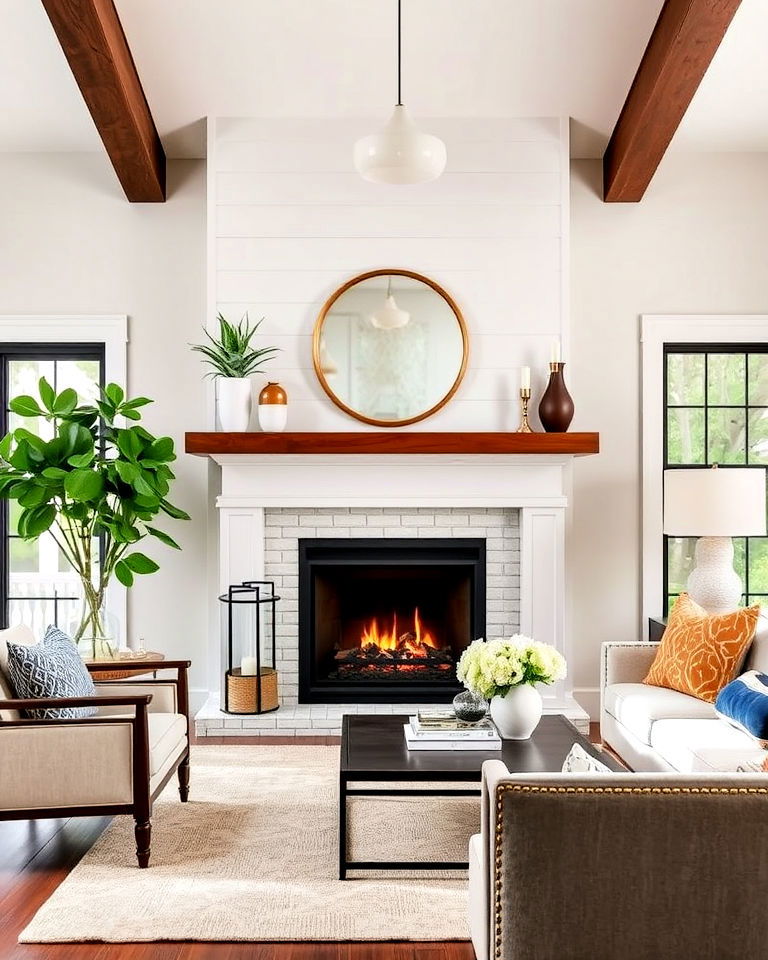
Create a cozy ambiance with a warm neutral transitional living room that feels inviting and serene. A cozy fireplace can be the perfect focal point for a transitional living room, blending warmth and style effortlessly. Whether you opt for rustic fireplace ideas with a traditional mantel or sleek, contemporary designs, the fireplace adds comfort to the space. It not only adds architectural interest but also serves as a gathering spot, enhancing the room's welcoming ambiance. This blend of classic and modern elements makes the space feel both homey and sophisticated.
16. Statement Area Rug
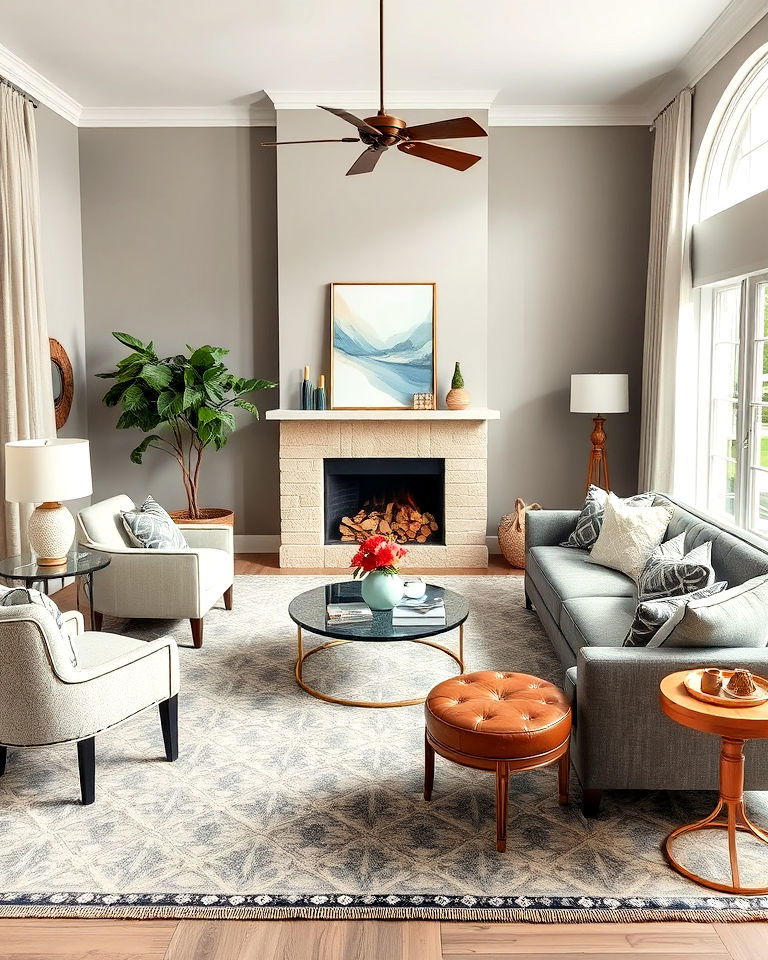
A statement area rug can anchor various elements, adding color and texture to transitional or rustic living room ideas for small spaces. Choose a rug with a bold design or a neutral pattern that complements both traditional and modern furniture. This piece serves as the foundation of the room's aesthetic, adding warmth and defining the seating area. An eye-catching rug can transform the room's look while maintaining a balance between its transitional elements.
17. Mix of Traditional and Contemporary Art
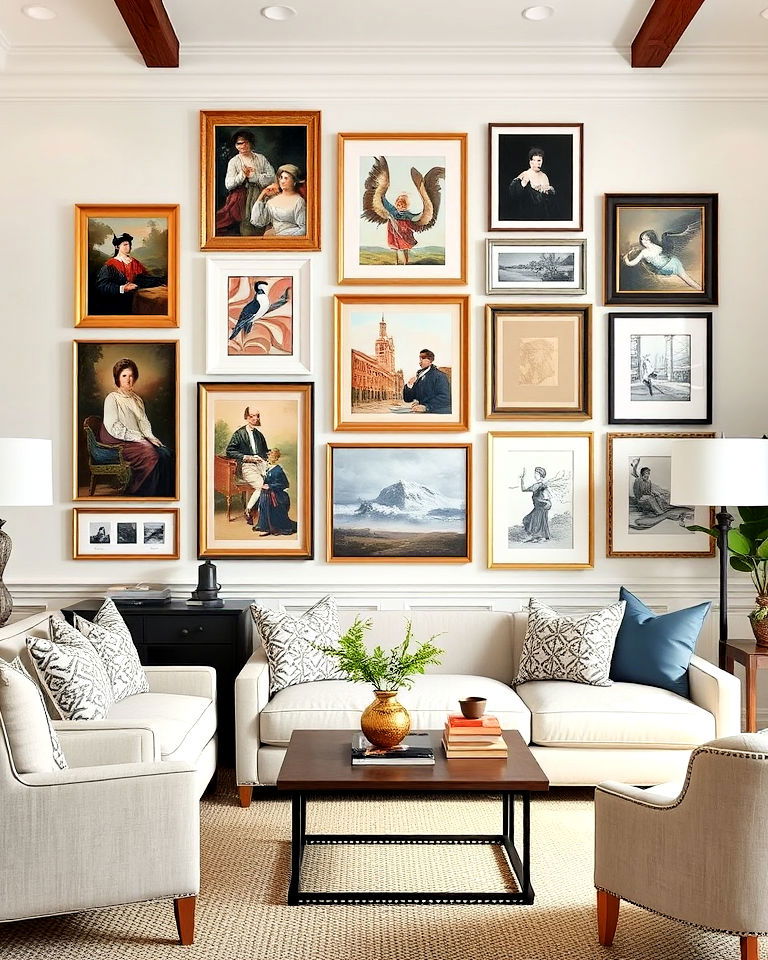
Curate a mix of traditional and contemporary art pieces to create a dynamic gallery wall in your living room. This approach allows you to showcase a variety of styles, blending classic paintings with modern prints or abstract pieces. The combination adds visual interest and reflects a transitional aesthetic that values both history and innovation. A well-balanced gallery wall can serve as a focal point, elevating the overall design of the space.
18. Incorporating Glass Elements
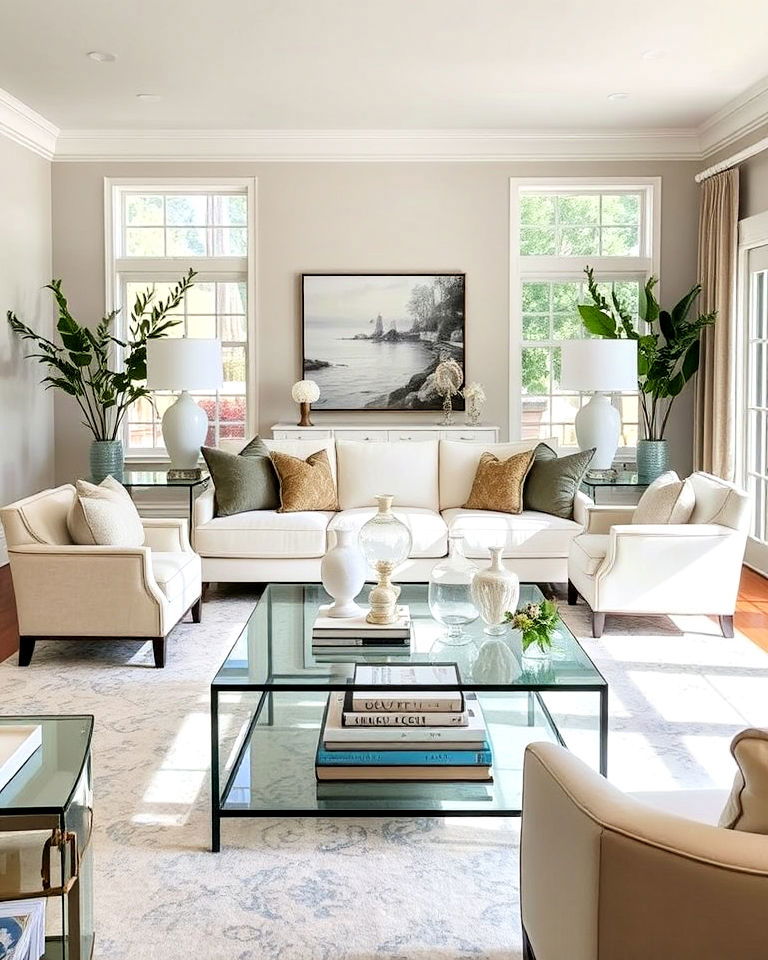
Adding glass elements to your transitional living room brings a touch of sophistication and openness. Glass coffee tables, side tables, or decor items like vases help to lighten the room's appearance and create a sense of spaciousness. These transparent touches work well with both traditional and modern pieces, making the room feel balanced and airy. Glass elements also reflect light beautifully, enhancing the overall brightness and elegance of the space.
19. Subtle Pops of Color
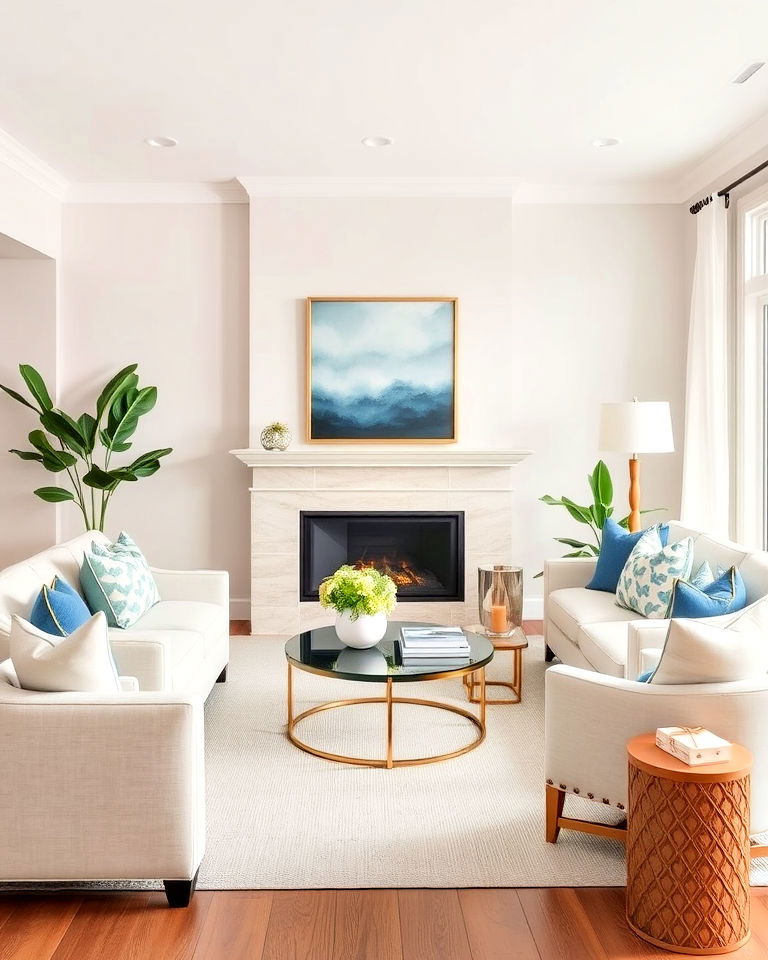
Introduce subtle pops of color into your neutral living room to infuse energy and personality without overpowering the transitional style. Use accents like cushions, artwork, or small decor items in hues like soft blues, greens, or golds. This technique adds vibrancy to the space while maintaining its overall calm and sophisticated vibe. A few well-placed color accents can make your living room feel lively and engaging, yet still cohesive.
20. Blending Antique and Modern Accessories
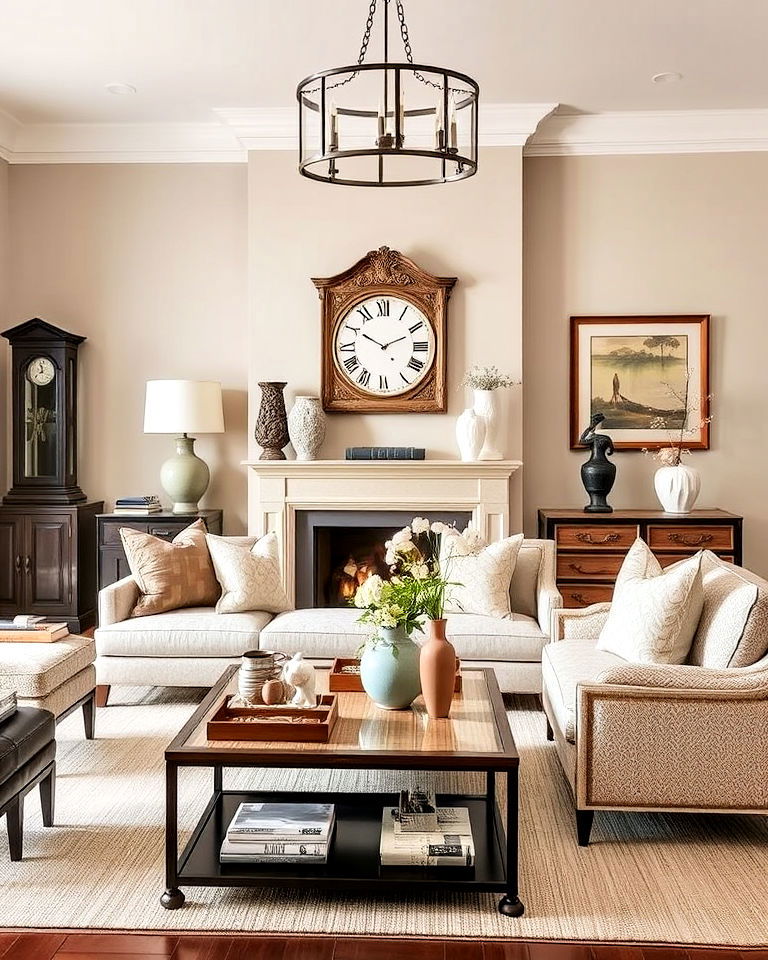
Elevate your home with living room transitional style interior design for a balanced mix of old and new. Blending antique and modern accessories can give your transitional living room a unique, personalized touch. Display a vintage clock or an antique mirror alongside sleek, contemporary sculptures or vases. This mix of old and new adds depth and character, making the space feel curated and thoughtfully designed. The combination highlights the transitional style's focus on merging different design eras to create a cohesive, elegant living environment.
21. Built-In Shelving Units
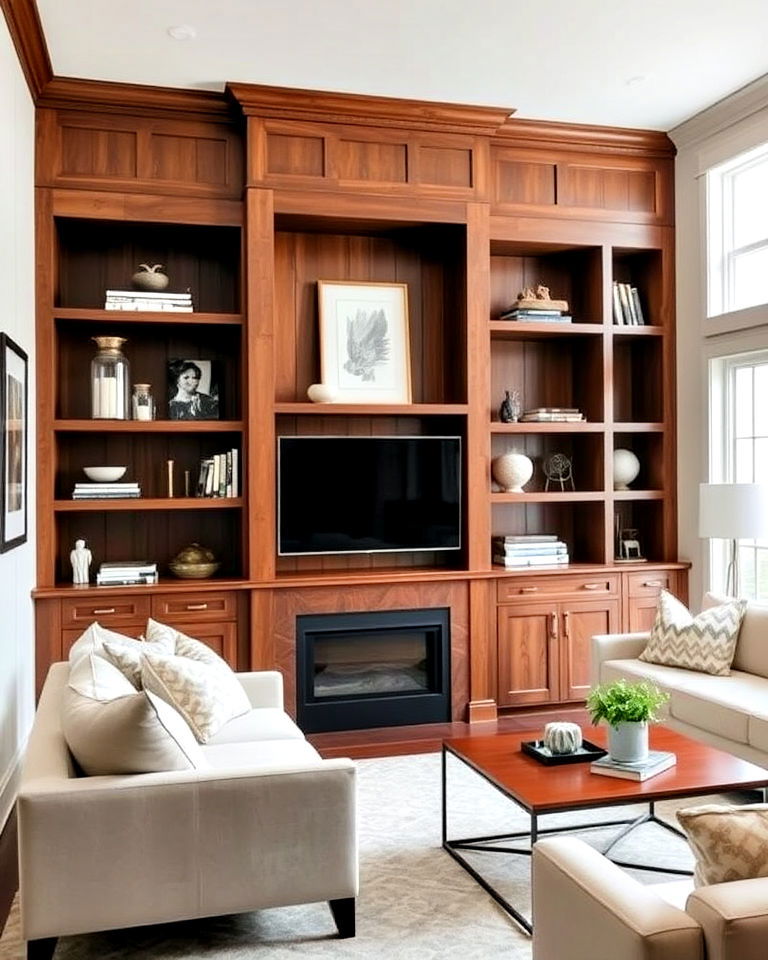
Built-in shelving units are an excellent way to combine functionality and style in a transitional living room. These shelves offer ample space for displaying decorative items, books, and personal mementos while keeping the room organized. By blending traditional wood finishes with modern lines, you create a cohesive look that complements both classic and contemporary elements. Built-in shelving adds architectural interest to the room, enhancing its overall design and making it feel polished and complete.
22. Mixed Seating Arrangements
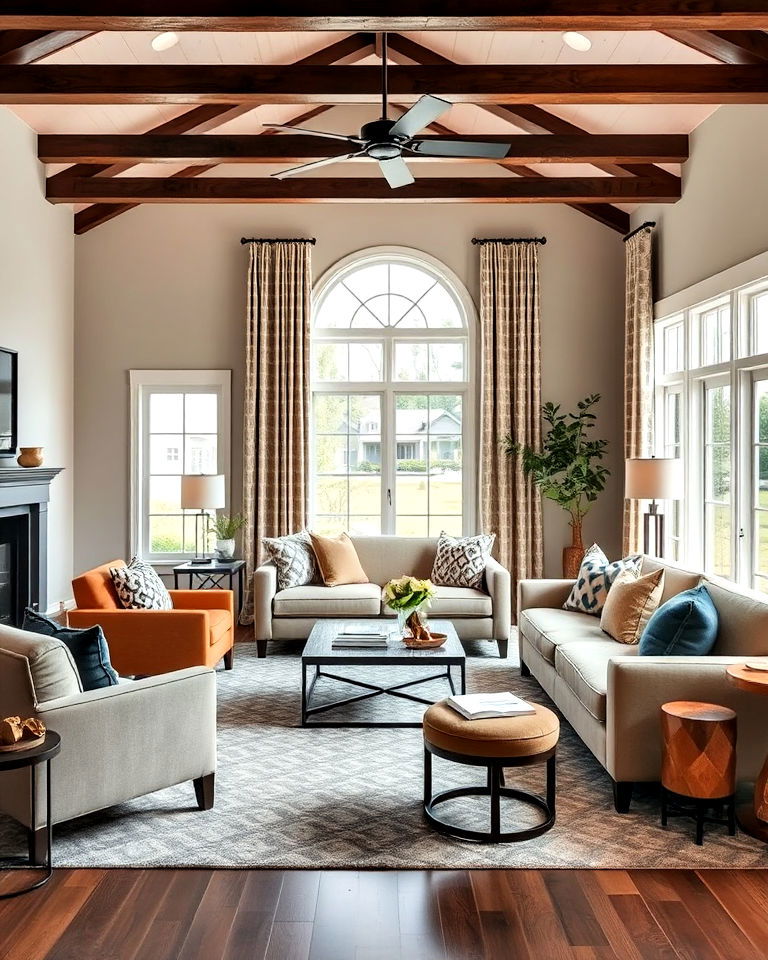
Experiment with mixed seating arrangements or living room couch ideas to create a versatile and inviting layout. Combining different types of seating, such as a traditional sofa with modern accent chairs, adds variety and character to the space. This approach encourages a more conversational atmosphere, making the room feel dynamic and engaging. Mixing seating styles is an excellent way to bridge the gap between traditional and contemporary, adding comfort while maintaining a balanced look.
23. Textured Wallpaper

Textured wallpaper can transform the look of a transitional living room by adding dimension and a subtle pattern to the walls. Choose designs like grasscloth or geometric prints in neutral tones to maintain a sophisticated vibe without overwhelming the space. This tactile element complements both modern and traditional furnishings, creating a harmonious blend of textures. Textured wallpaper acts as an elegant backdrop that enhances the room's overall aesthetic and style.
24. Black and White Accents
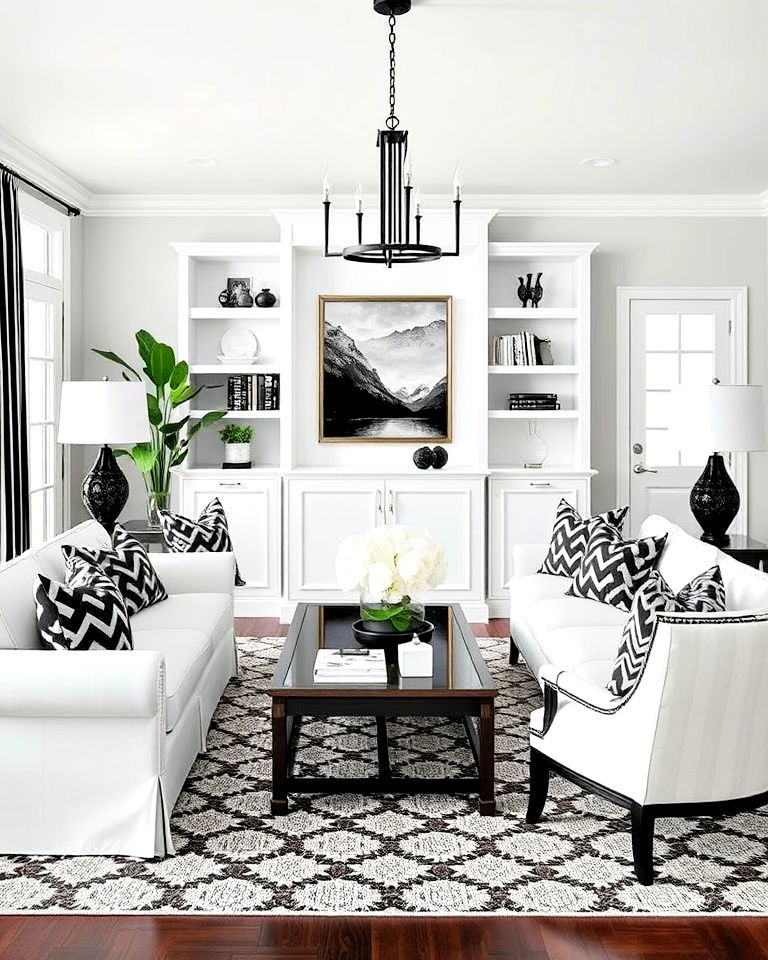
Utilize black and white accents to bring a crisp, modern edge to your transitional living room. These contrasting colors add a touch of drama and sophistication, enhancing the room's visual impact without clashing with its traditional elements. Incorporate black and white through patterned cushions, artwork, or even furniture pieces to create a striking, balanced look. This timeless color scheme highlights the transitional style's emphasis on clean lines and elegant simplicity.
25. Rustic Touches
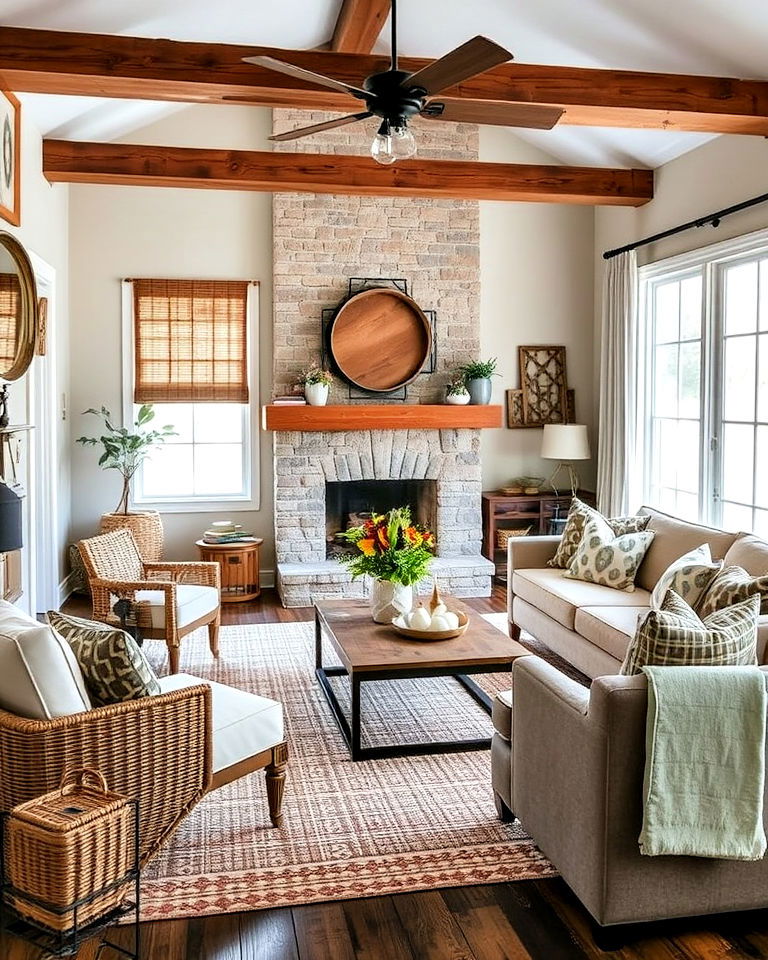
Adding rustic touches can give a warm, organic feel to a transitional living room. Incorporate reclaimed wood furniture, woven baskets, or natural stone elements to bring an earthy vibe to the space. These rustic details pair beautifully with sleek, modern designs, creating a layered look that feels both cozy and stylish. The blend of textures and natural materials adds character, making the room feel more inviting and grounded.
26. Open Shelving for Display
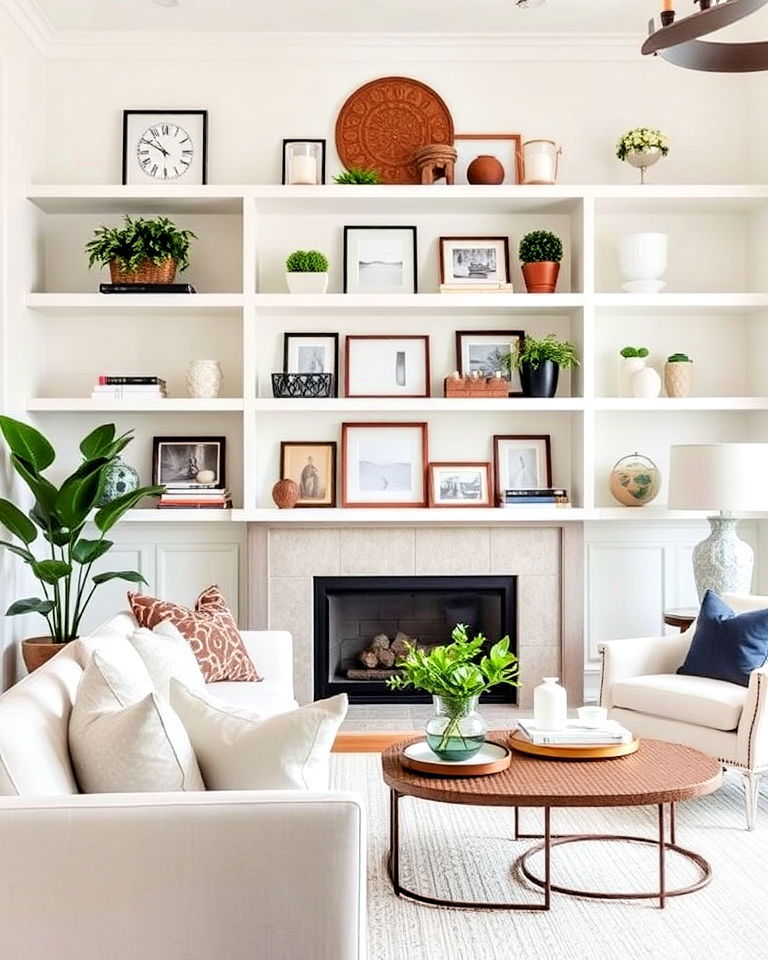
Get inspired by stylish transitional living rooms that offer both comfort and sophistication. Open shelving is a fantastic way to showcase your favorite decor items and personal collections in a transitional living room. Arrange decorative objects, books, or plants in a way that feels curated yet casual. Open shelving works well in this style because it allows you to blend traditional accessories with contemporary pieces, creating a balanced display. This design choice adds visual interest without overwhelming the space, enhancing its open and airy feel.
27. Decorative Mirrors

Incorporate decorative mirrors into your living room design to enhance light and create the illusion of a larger space. Mirrors with ornate frames can add a traditional touch, while sleek designs keep the room feeling modern. Placing a mirror strategically on a feature wall not only reflects light but also serves as an eye-catching focal point. This simple yet effective element ties together the transitional style, making the room feel brighter and more expansive.
28. Transitional Sofa with Clean Lines
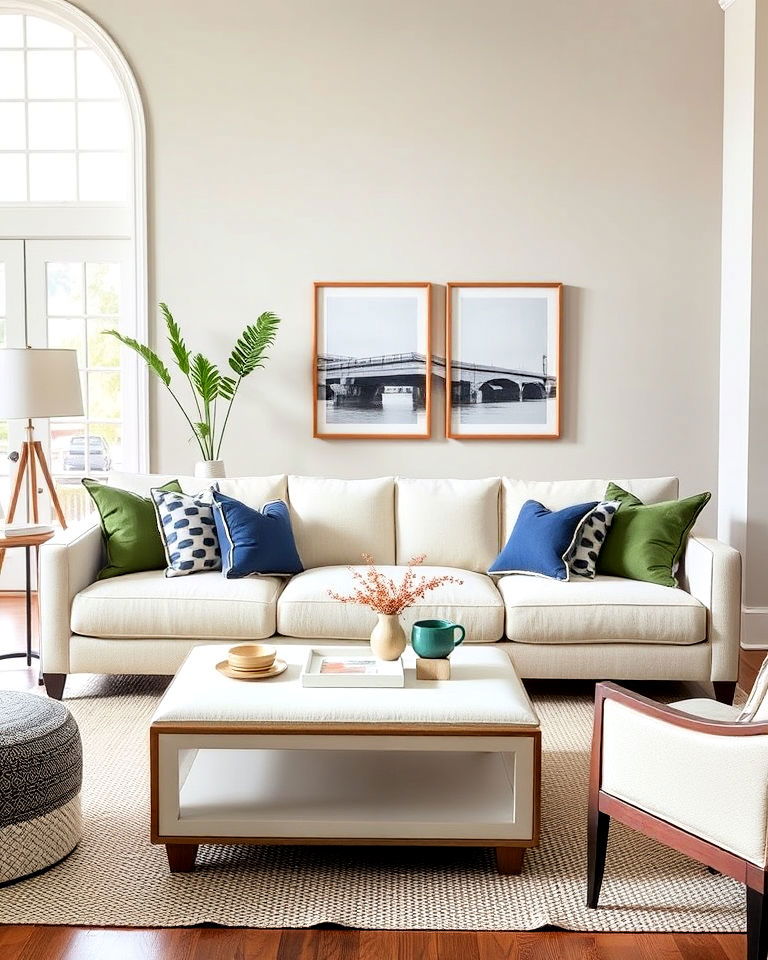
A transitional sofa with clean lines is the perfect centerpiece for this style of living room. Opt for a design that features subtle curves with a contemporary silhouette, blending comfort with sophistication. This type of sofa serves as a versatile anchor that complements both classic and modern decor, allowing you to easily refresh the room's look over time. Its understated elegance makes it a timeless addition to your living space.
29. Layered Window Treatments
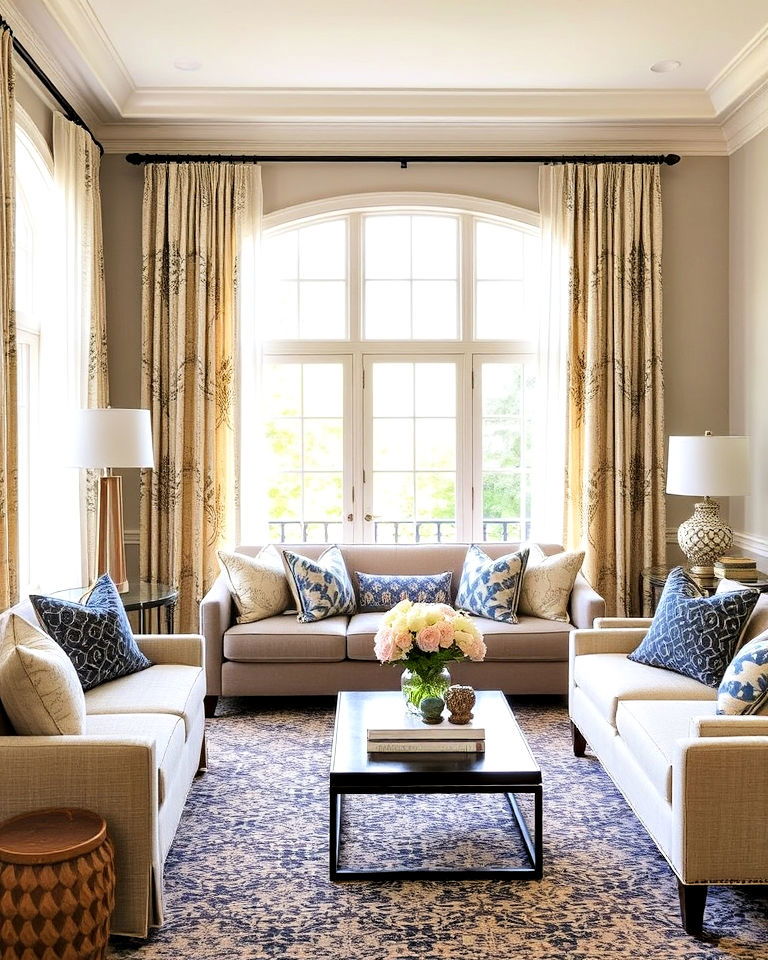
Layering window treatments can add depth and softness to your living room while controlling light and privacy. Combine sheer curtains with heavier drapes to create a look that's both functional and stylish. This layered approach enhances the room's texture and adds a touch of luxury, making the space feel more polished. Window treatments in complementary fabrics and colors help balance the traditional and modern elements of the transitional style.
30. Incorporating Artwork in Neutral Tones
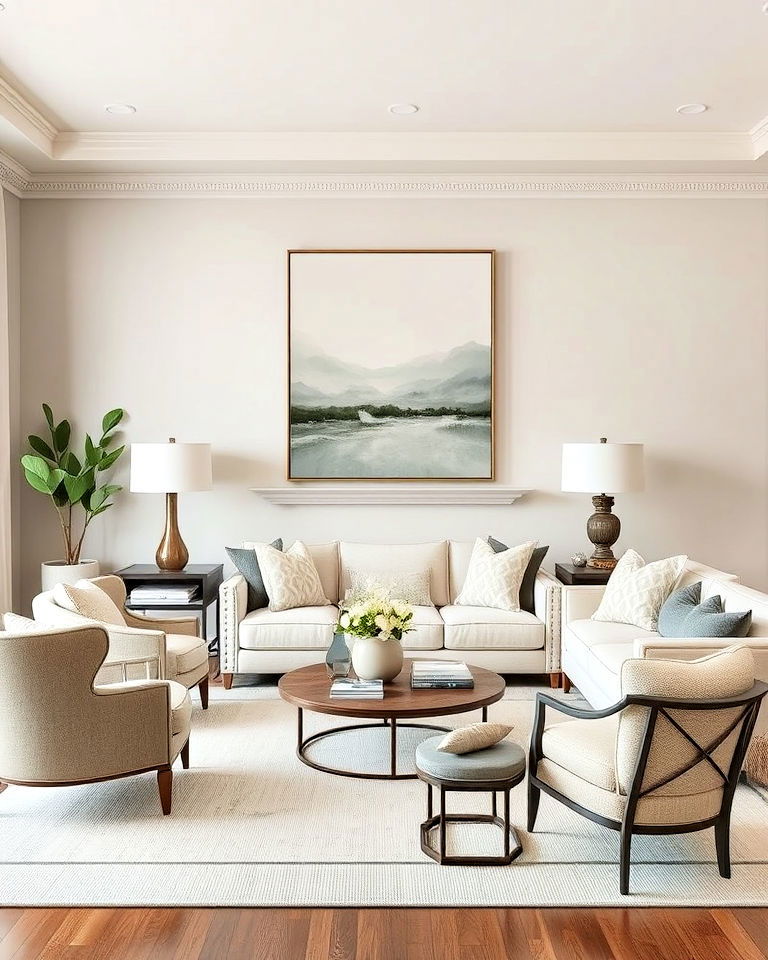
Artwork in neutral tones can add sophistication to your transitional living room without dominating the space. Choose pieces that feature subtle hues like beige, gray, or muted blues to maintain the room's calm and cohesive feel. Neutral artwork blends seamlessly with the overall color palette, enhancing the visual harmony of the room. This approach allows the art to complement rather than compete with other design elements, reinforcing the elegant simplicity of the space.
31. Exposed Wood Beams
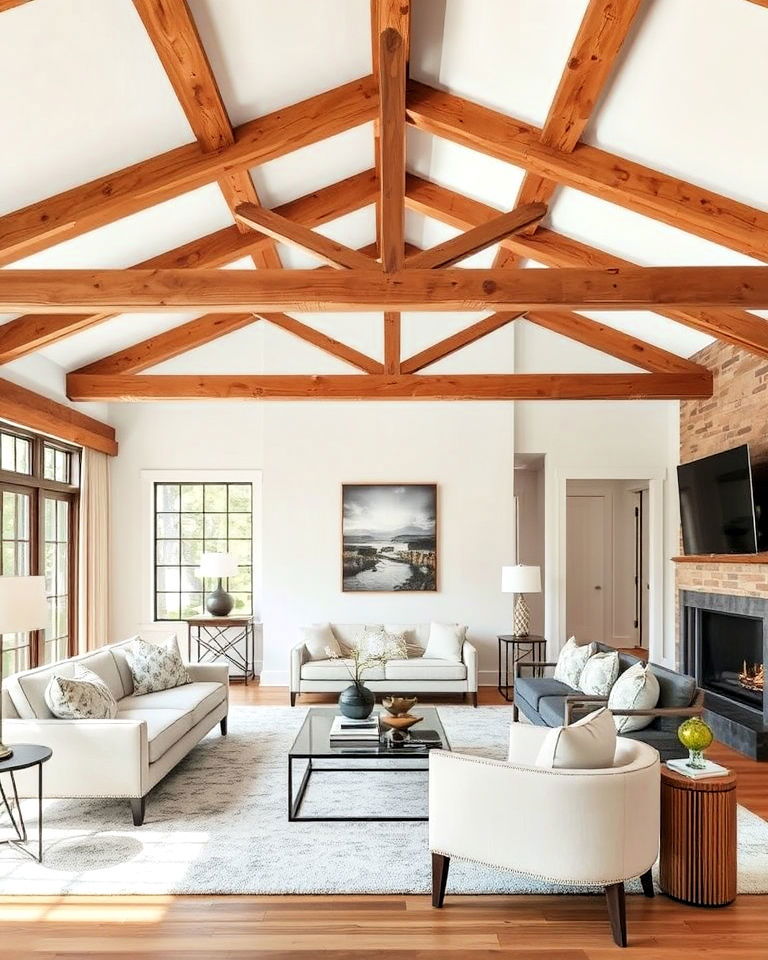
Find sleek and inviting transitional modern living room ideas to create a perfect harmony of styles. Exposed wood beams can add a rustic touch to a transitional living room, creating a focal point that exudes warmth and character. The natural texture of the wood contrasts beautifully with modern furniture and sleek decor elements. This architectural feature enhances the room's structural charm while blending seamlessly with both traditional and contemporary styles. Wood beams not only add visual interest but also contribute to a cozy, inviting atmosphere.
32. Geometric Patterns in Decor
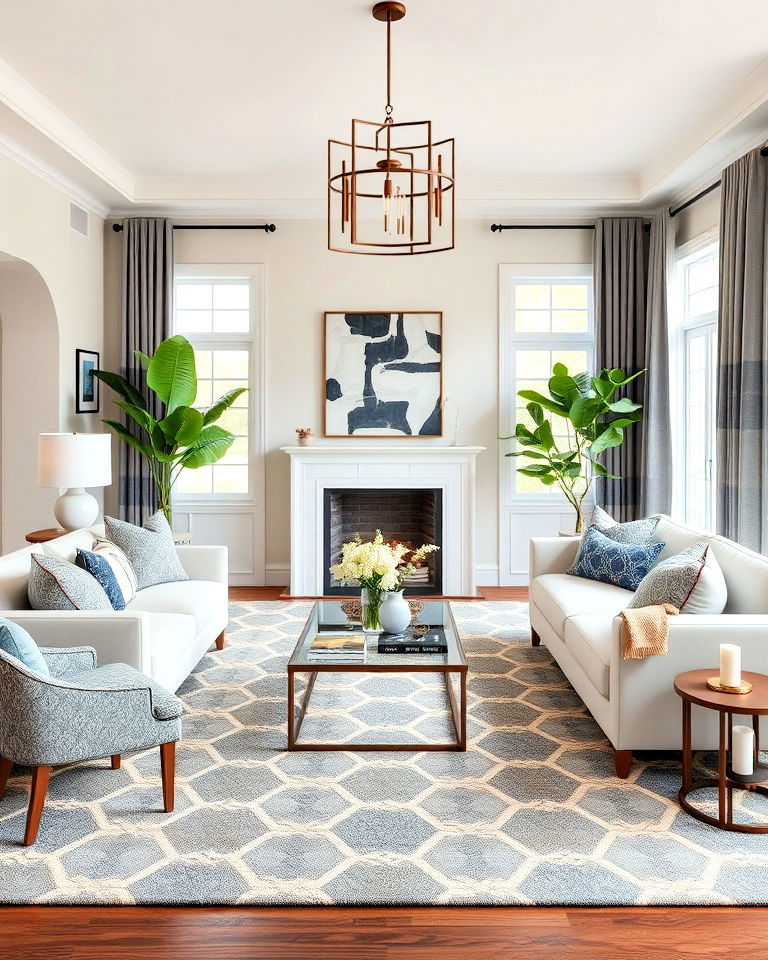
Incorporate geometric patterns into your decor to introduce a modern edge to the living room. Use patterned cushions, rugs, or wall art that feature shapes like hexagons, stripes, or diamonds. Geometric designs bring a dynamic feel to the space, balancing out the classic elements with contemporary flair. These patterns add energy and movement, making the room feel fresh and up-to-date without detracting from its transitional roots.
33. Earthy Color Accents
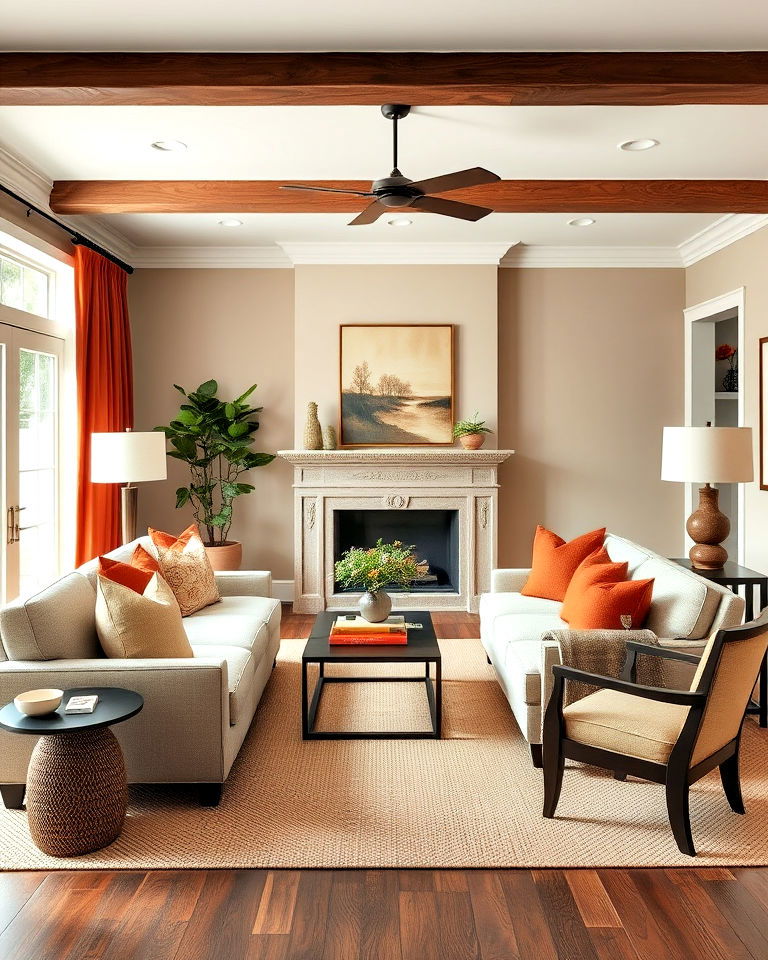
Earthy living room ideas, such as incorporating terracotta, olive green, or warm browns, can infuse a transitional space with a natural, grounded feel. These hues work well with a neutral base, adding warmth and depth to the overall palette. Integrating these colors through pillows, throws, or wall art can create a cozy yet sophisticated atmosphere. Earthy tones complement both traditional and modern elements, enhancing the room's inviting and balanced aesthetic.
34. Floating Shelves
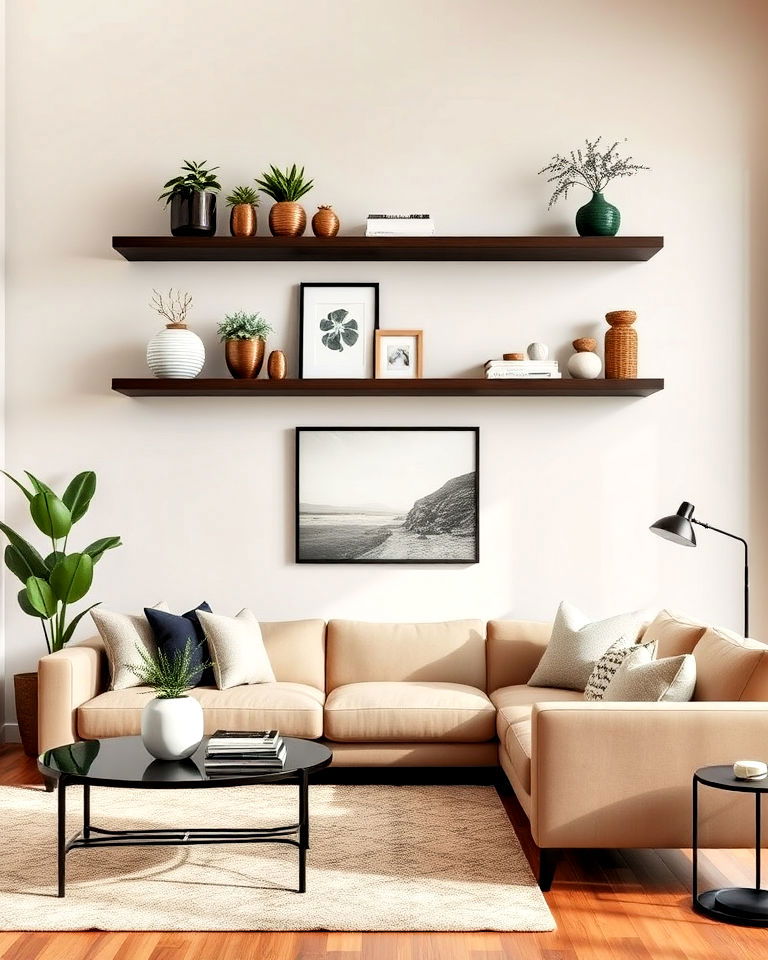
Floating shelves are a sleek, modern way to display decor in a transitional living room without taking up floor space. Use them to showcase plants, artwork, or small decorative items that reflect your personal style. The clean lines of floating shelves blend effortlessly with both contemporary and traditional furnishings, adding an element of sophistication. This practical storage solution keeps the room organized while contributing to its overall design.
35. Accent Chairs with Unique Designs
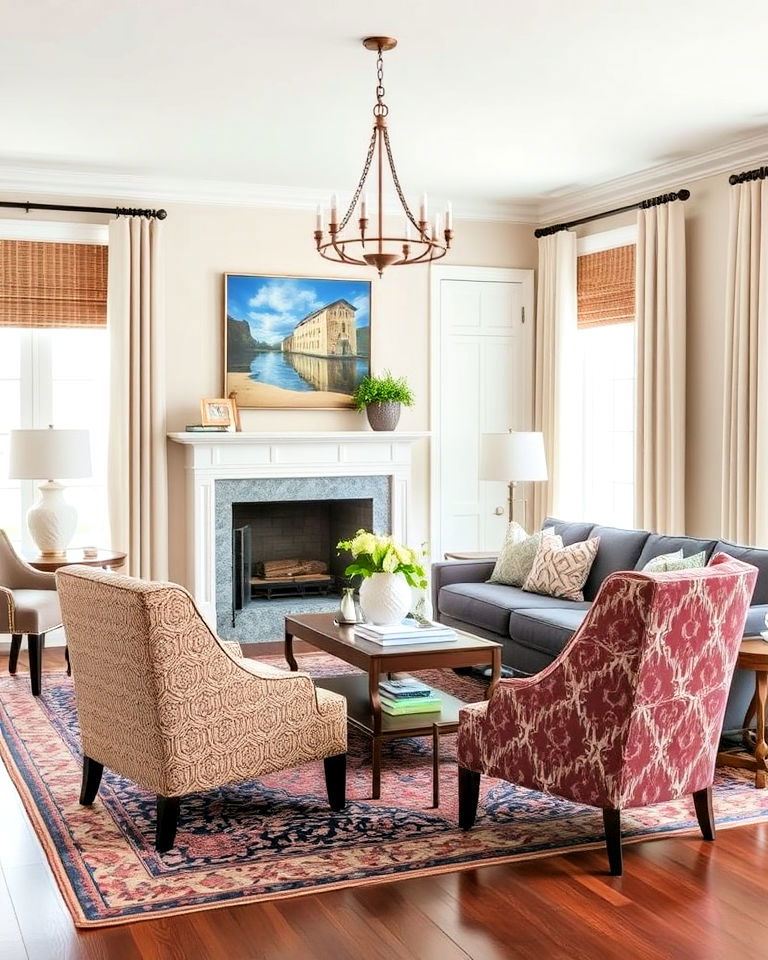
Accent chairs with unique designs can serve as statement pieces in a transitional living room. Look for chairs that combine classic shapes with modern fabrics or bold patterns to create visual interest. These chairs can add a pop of color or texture, enhancing the room's dynamic feel without overwhelming the space. The right accent chair can bridge the gap between traditional and contemporary styles, making it a focal point in the room.
36. Incorporating Woven Textiles
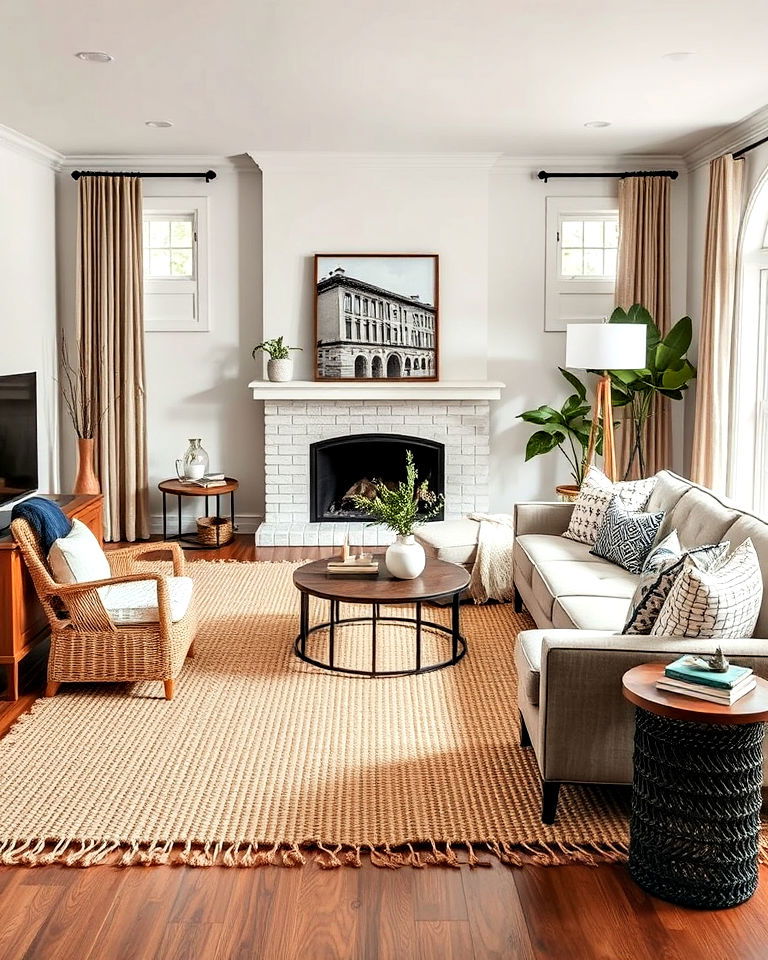
Woven textiles, like throws, cushions, or rugs, can bring a touch of coziness and texture to your living room. Choose natural materials like cotton, wool, or jute to add warmth and a handcrafted feel to the space. Woven elements work beautifully in a transitional setting, where they complement both the clean lines of modern design and the softness of traditional decor. This tactile layer enhances the room's comfort and visual appeal.
37. Neutral Tone Layering
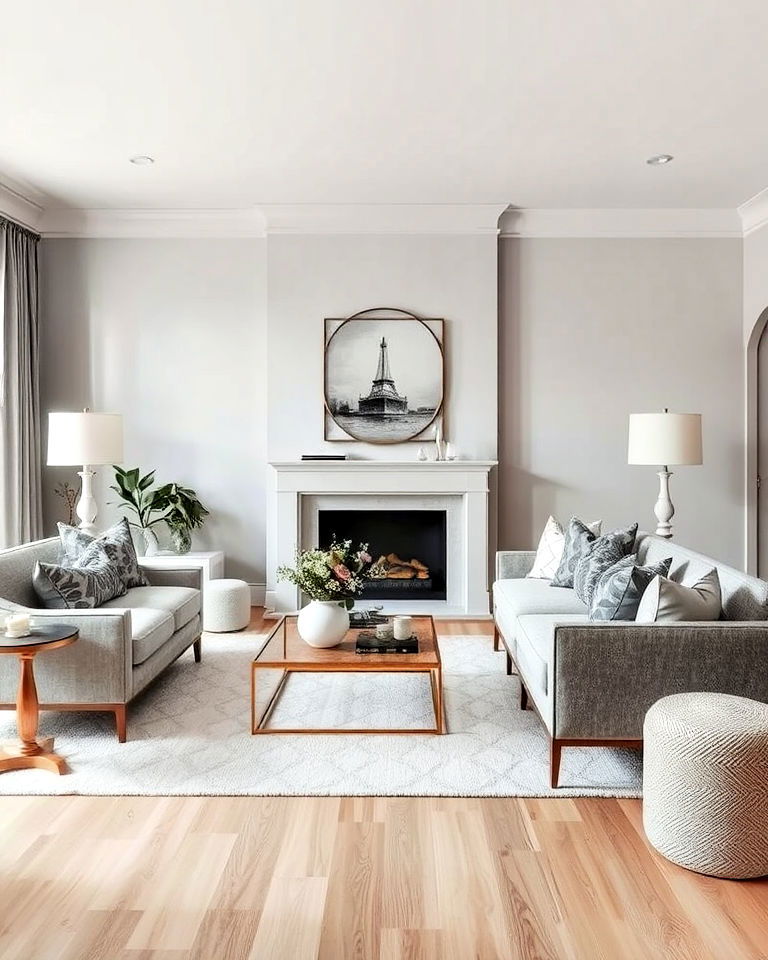
Layering different shades of neutral tones in your living room can create a sophisticated and serene environment. Combine various hues of beige, gray, and cream through furniture, textiles, and decor to add depth and dimension to the space. This approach enhances the room's elegance, creating a calm backdrop that makes other elements stand out. Layering neutrals allows you to play with textures and finishes, achieving a look that is both cohesive and inviting.
38. Vintage Rugs
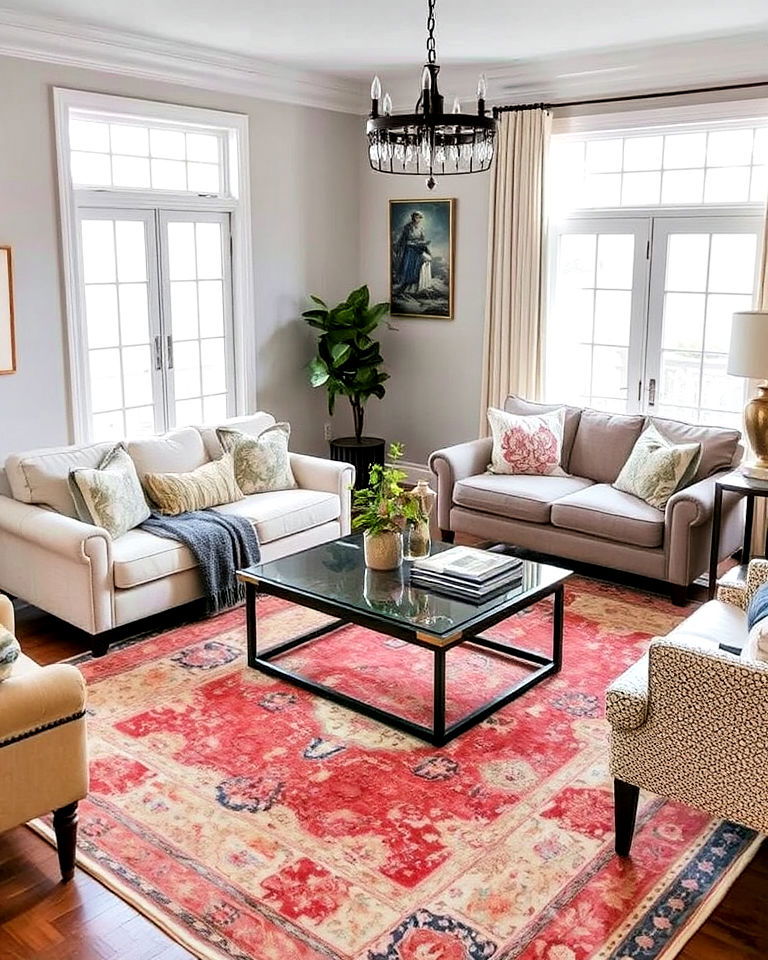
Vintage decor ideas, including a rug, can be the perfect finishing touch to a transitional living room, adding nostalgia and character. Look for rugs with classic patterns and faded colors that blend seamlessly with both traditional and modern furnishings. Vintage rugs bring warmth and texture to the floor, grounding the space with a sense of history. This timeless piece can tie the room together, enhancing its overall design and creating a cozy, lived-in feel.
39. Sleek Coffee Tables
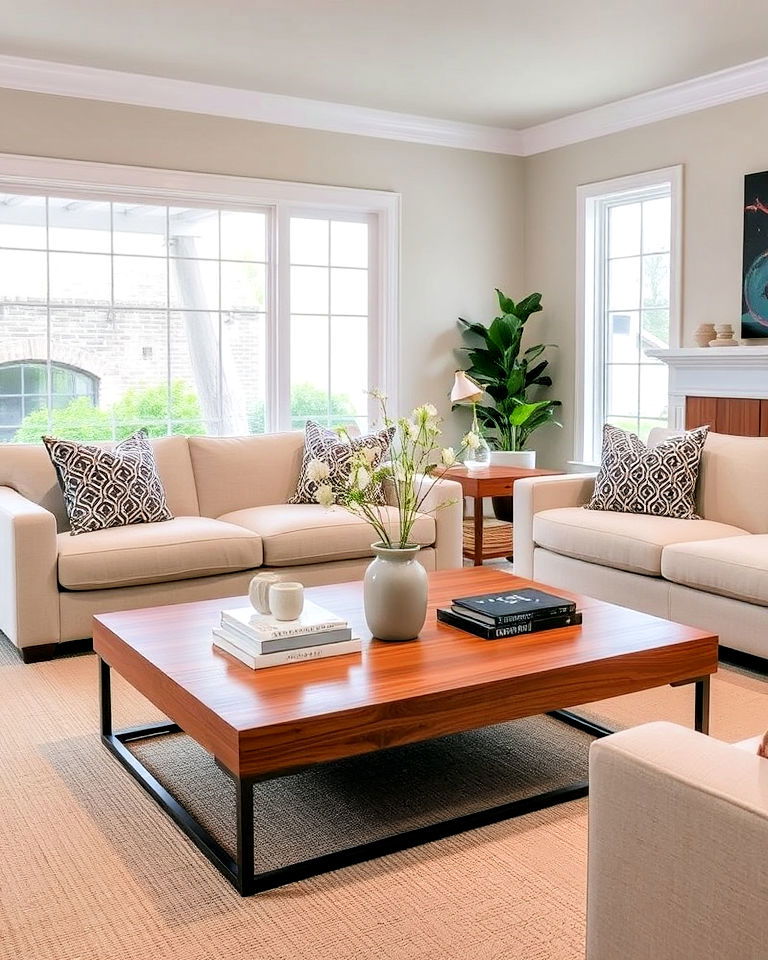
Choose a sleek coffee table with clean lines to anchor your transitional living room. Opt for materials like glass, metal, or polished wood that offer a contemporary feel while maintaining an elegant presence. A minimalist coffee table design serves as a versatile piece that complements various seating arrangements and decor styles. This functional yet stylish element adds a touch of modernity to the room, balancing out its traditional accents.
40. Sculptural Decor Elements
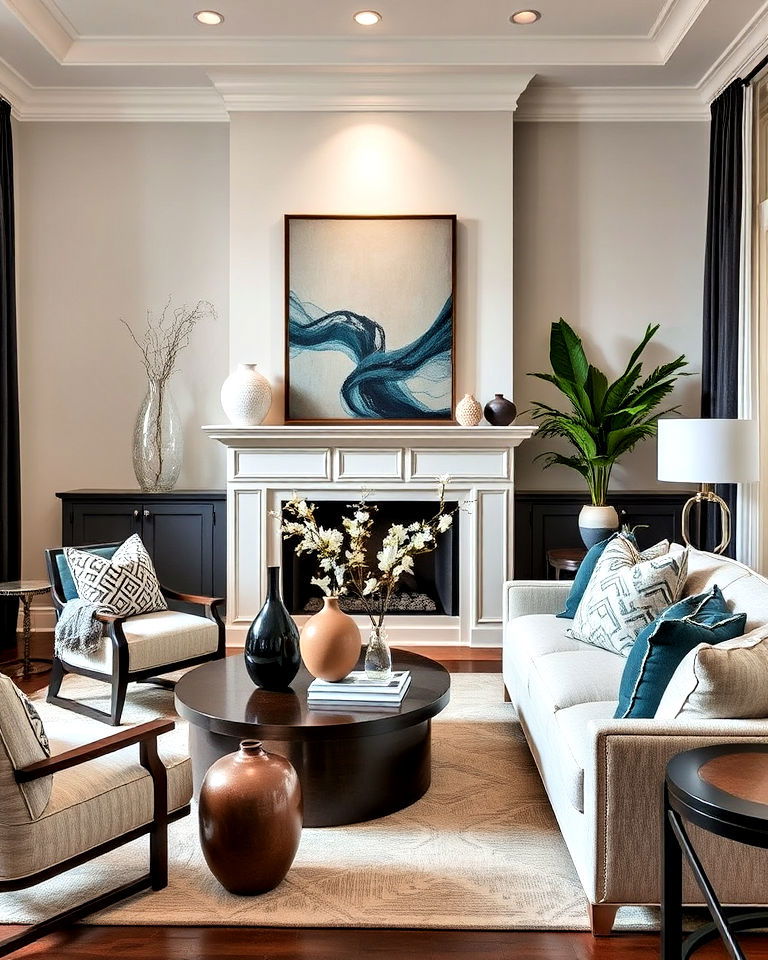
Incorporating sculptural decor elements, like vases, bowls, or abstract sculptures, can elevate the artistic feel of your living room. These pieces add a touch of creativity and form, blending seamlessly with both classic and contemporary designs. Sculptural items work well as eye-catching accents on shelves, tables, or mantels, enhancing the room's overall texture and visual interest. This approach adds a layer of sophistication, making the space feel thoughtfully curated and unique.
Conclusion
Creating a transitional living room offers the best of both worlds by blending modern and traditional design elements. These 40 transitional living room ideas provide practical inspiration for achieving a stylish, balanced space that stands the test of time. Whether it's mixing textures, incorporating statement lighting, or choosing the right color palette, each tip adds to the room's overall elegance. Remember, the goal is to create a space that feels both welcoming and sophisticated, reflecting your unique style while remaining versatile for future updates.
Key Points:
- Blend of Traditional and Modern: The essence of transitional living room design lies in seamlessly mixing classic and contemporary elements to create a balanced, timeless space.
- Neutral Color Palette: Use a base of neutral tones like beige, gray, and taupe to maintain versatility and allow for easy integration of accent colors.
- Layered Textures and Patterns: Incorporate a variety of textures and patterns to add depth and visual interest, enhancing both comfort and elegance.
- Statement Elements: Features like bold lighting fixtures, accent walls, and unique furniture pieces play a crucial role in adding character to the room.
- Multi-Functional and Open Design: Emphasize practicality with multi-functional furniture and layouts that support open floor plans, enhancing the room's usability and spaciousness.
- Natural and Rustic Touches: Integrate natural materials and rustic accents to create a warm, inviting atmosphere that complements the modern elements.
- Art and Decor: A blend of classic and contemporary artwork, combined with sculptural decor pieces, contributes to a sophisticated and cohesive visual experience.
- Symmetry and Balance: Utilize symmetry in furniture placement to establish a sense of order and harmony within the room.
What to Do Next:
- Evaluate Your Space: Assess your living room's current style and identify which traditional or modern elements you want to highlight or introduce.
- Choose a Color Palette: Select a neutral base and decide on accent colors or patterns that will bring the space to life without overwhelming it.
- Incorporate Statement Pieces: Invest in one or two eye-catching items like a lighting fixture, accent chair, or bold rug that can serve as the focal point of your room.
- Mix Textures and Materials: Begin layering textures through textiles, furniture, and decorative items to create depth and warmth.
- Update with Versatile Furniture: Opt for multi-functional furniture pieces that enhance the room's functionality while maintaining a sleek appearance.
- Refine with Art and Accessories: Curate a mix of classic and contemporary art that ties together the room's traditional and modern elements.
- Focus on Symmetry: Arrange your furniture and decor to maintain a balanced, harmonious layout that reflects the transitional style's structured elegance.

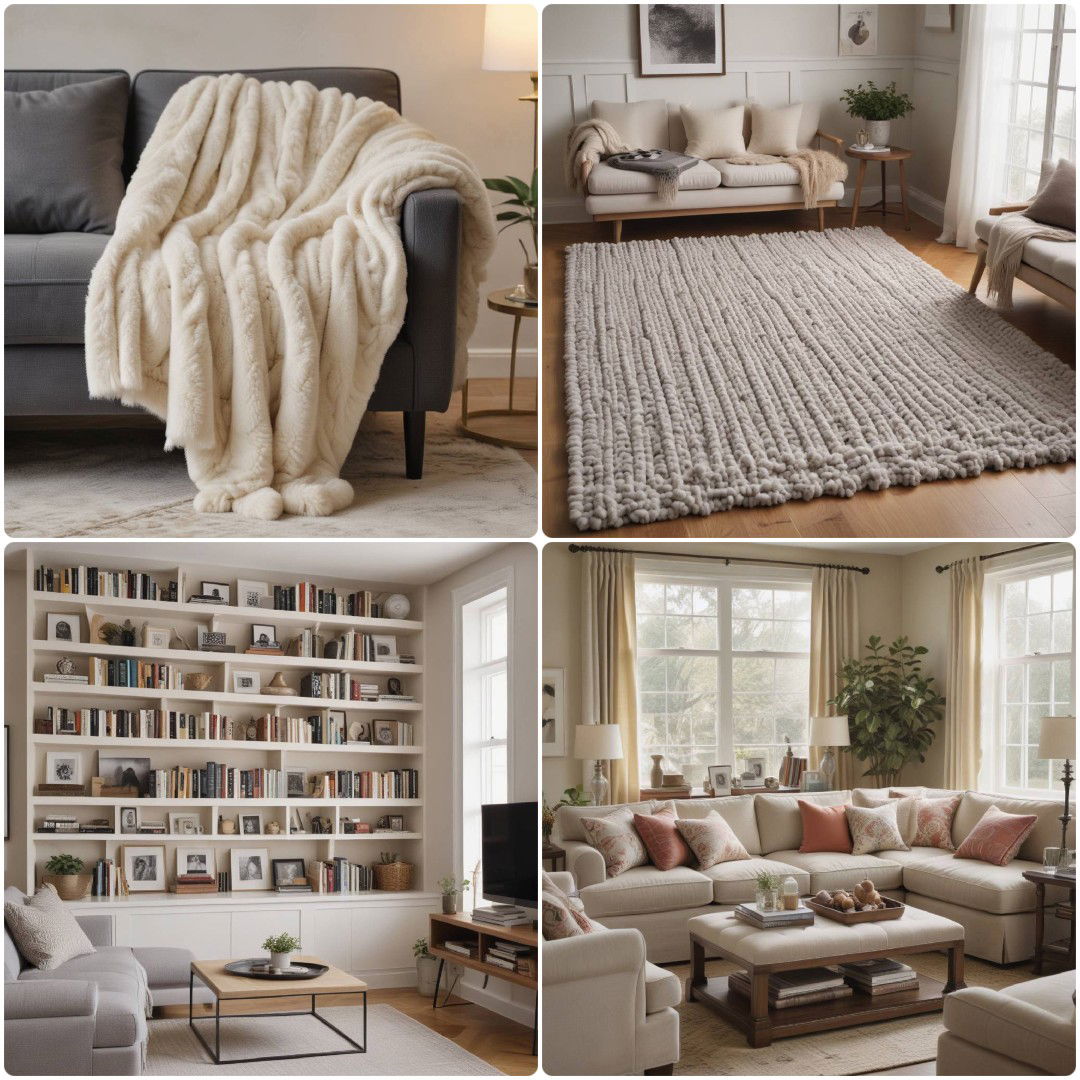
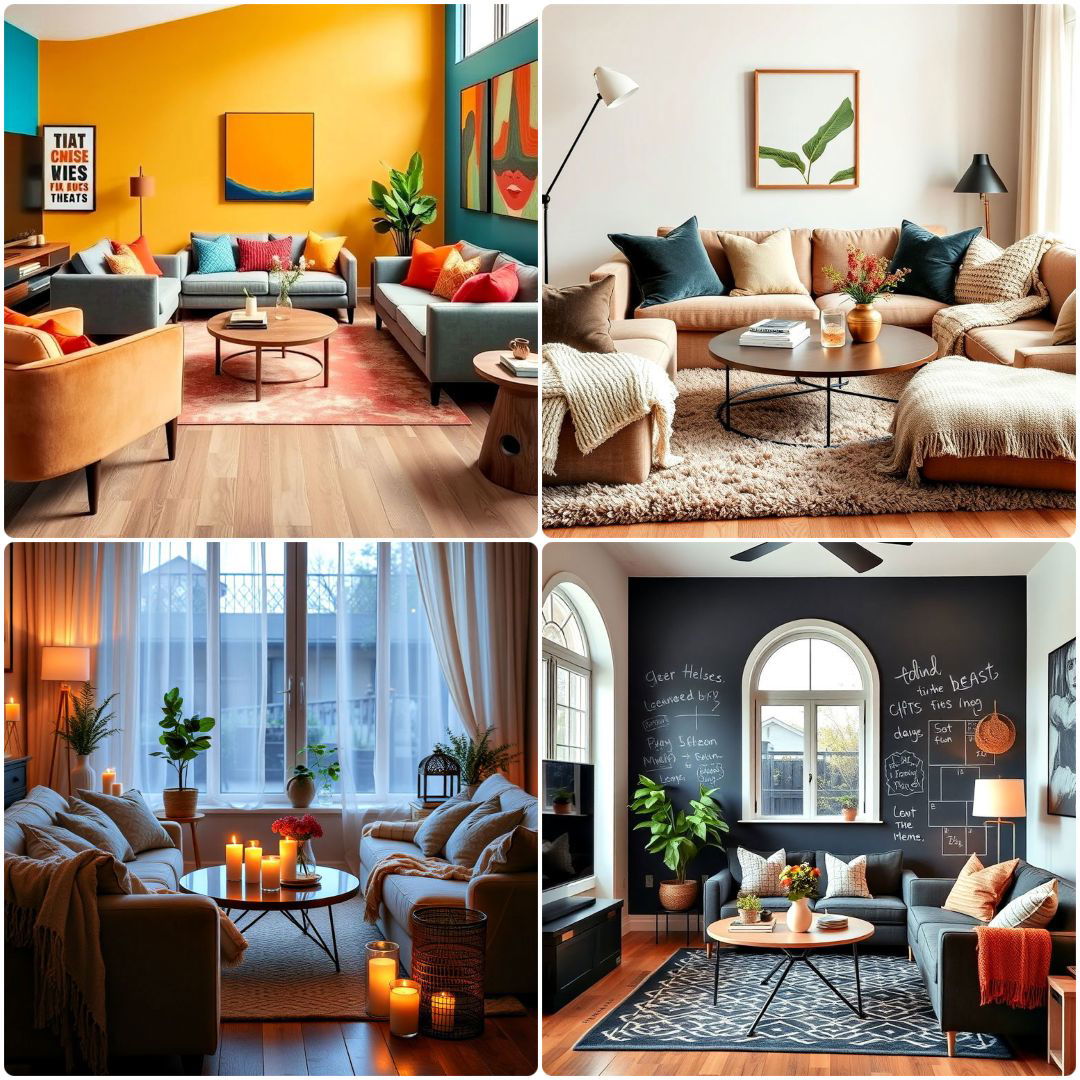
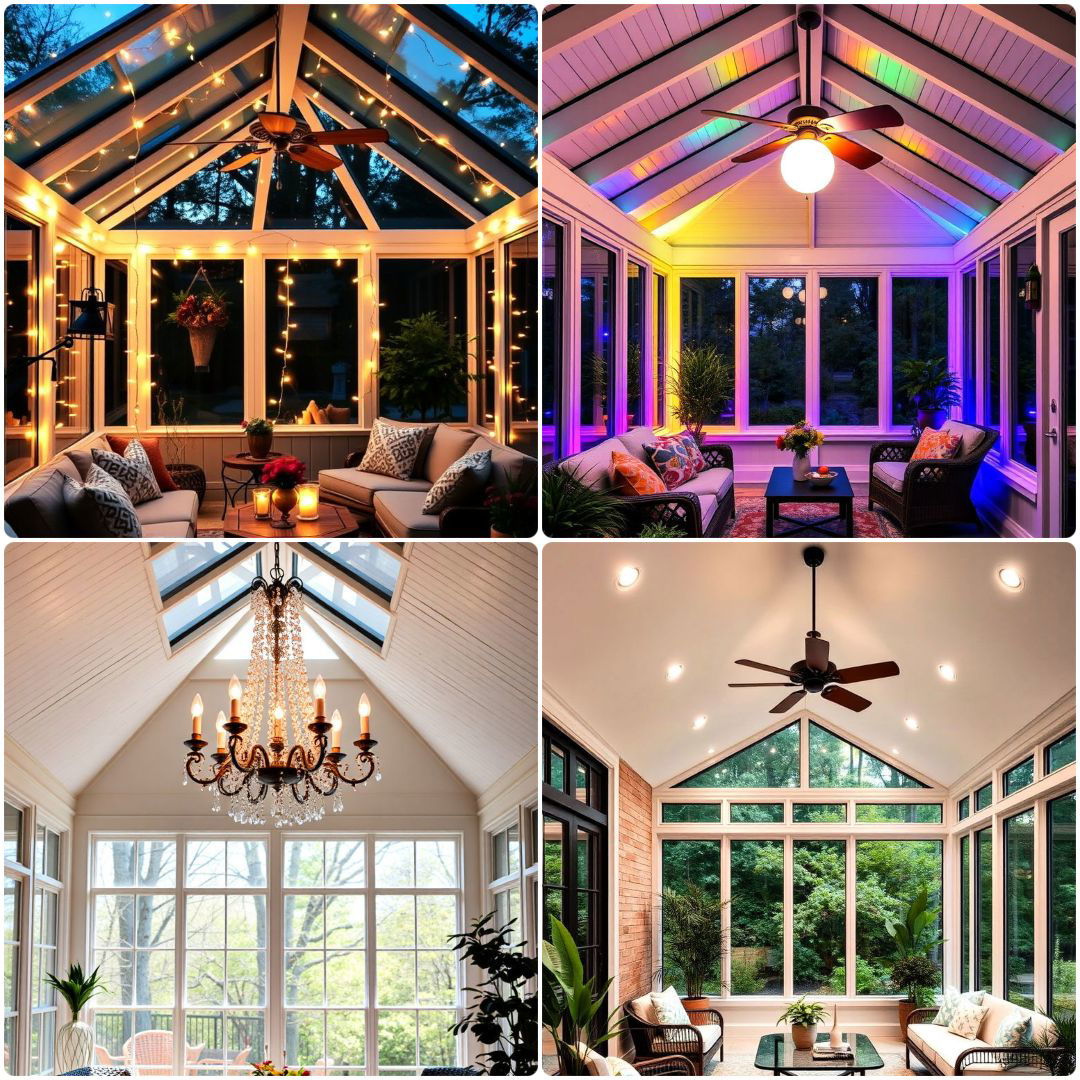
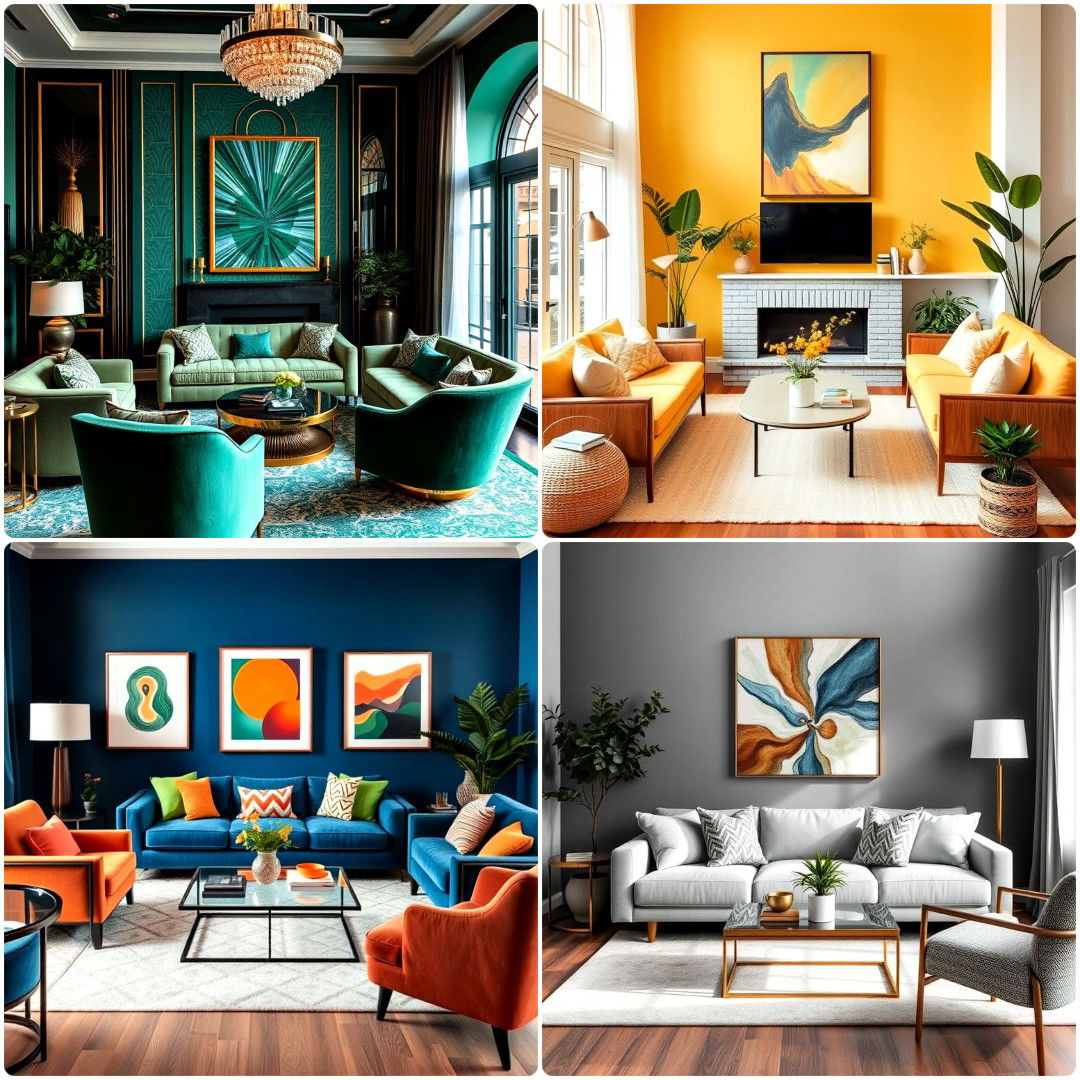
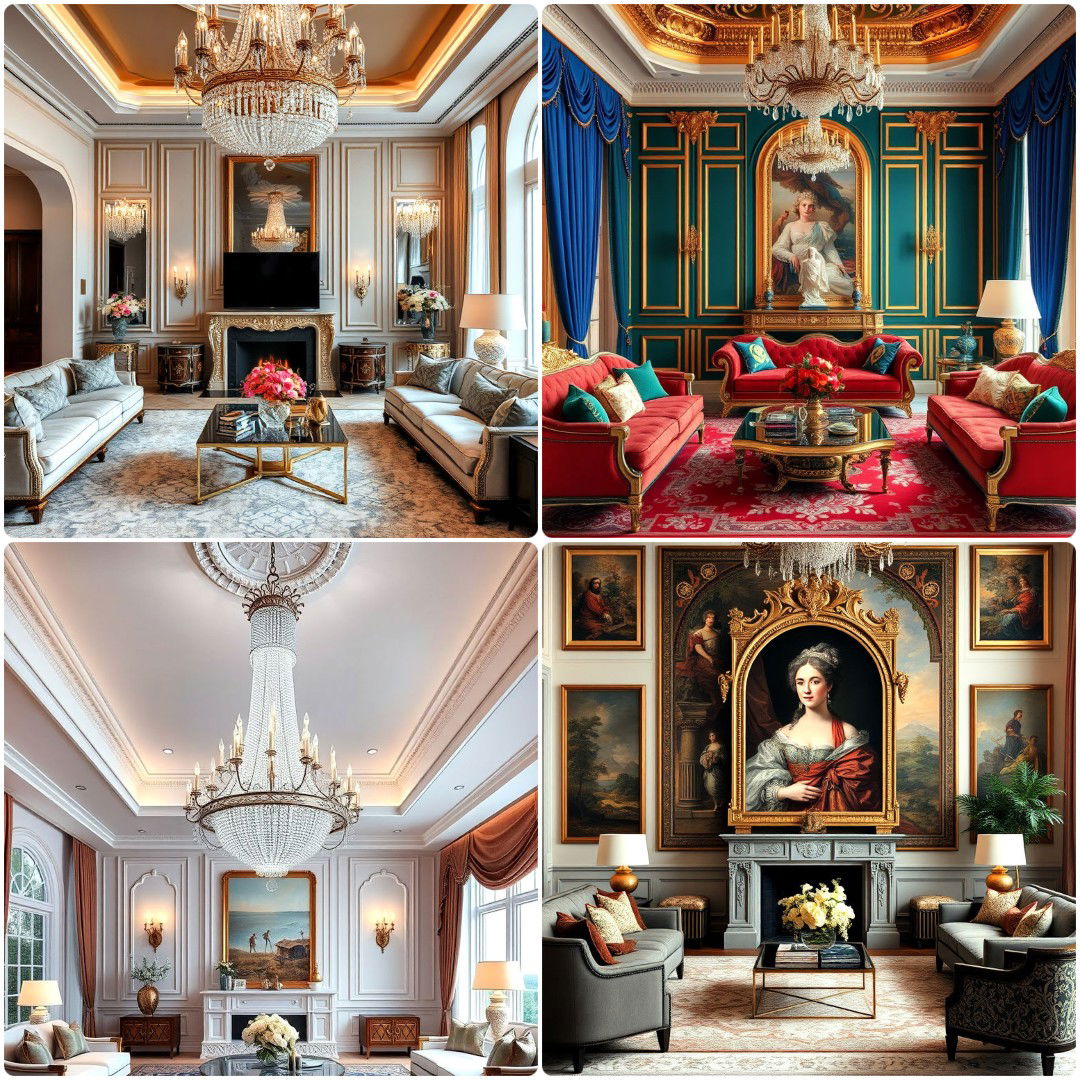

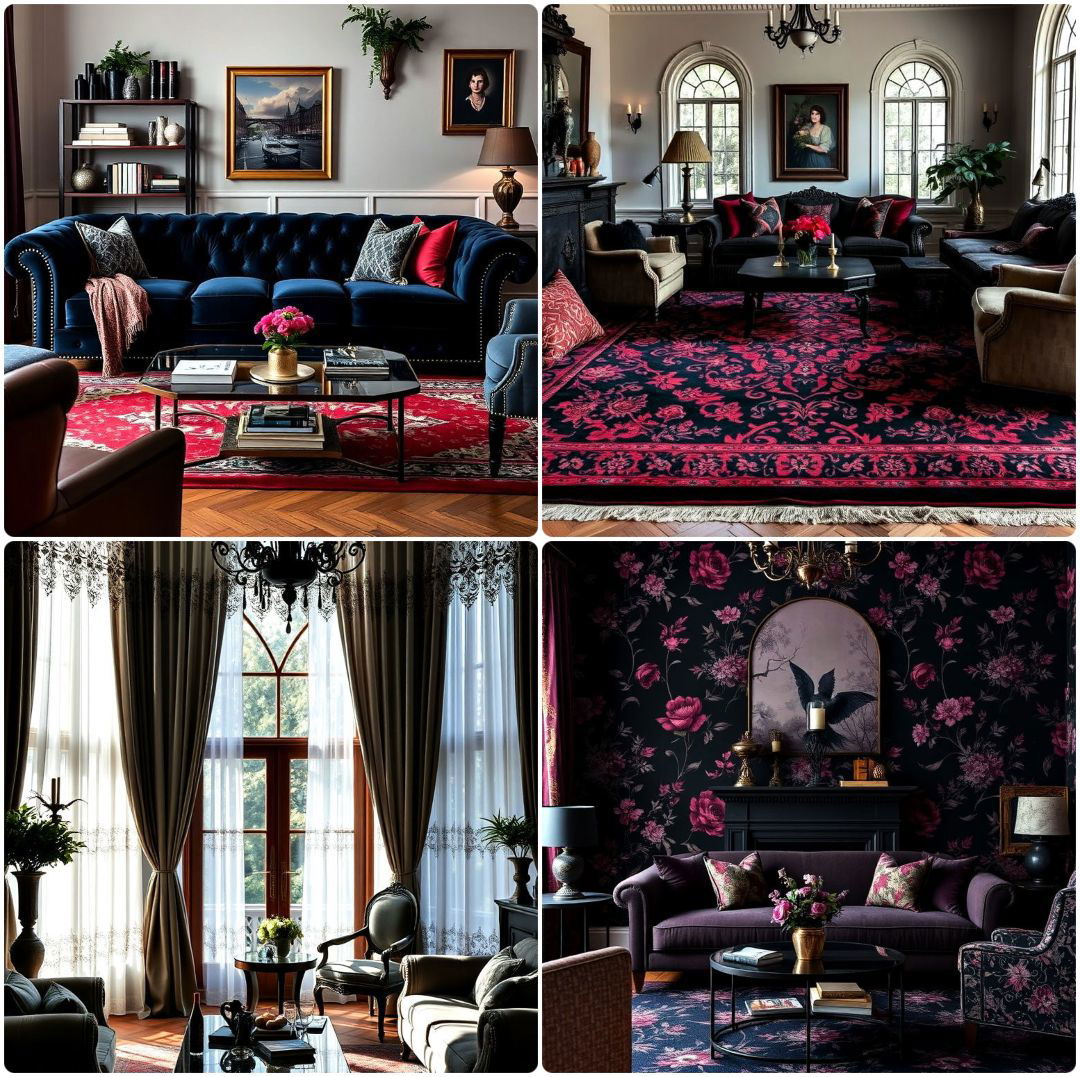
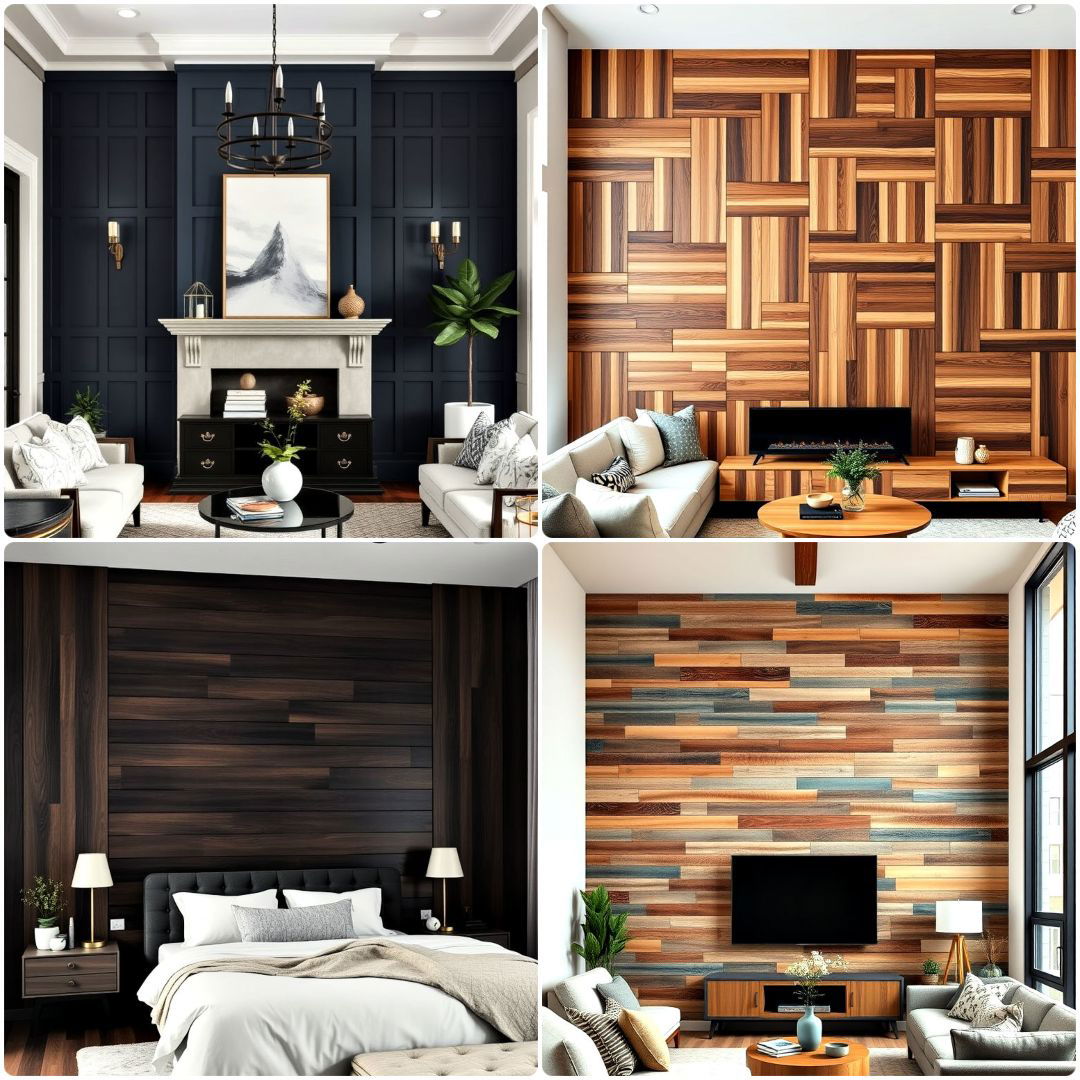
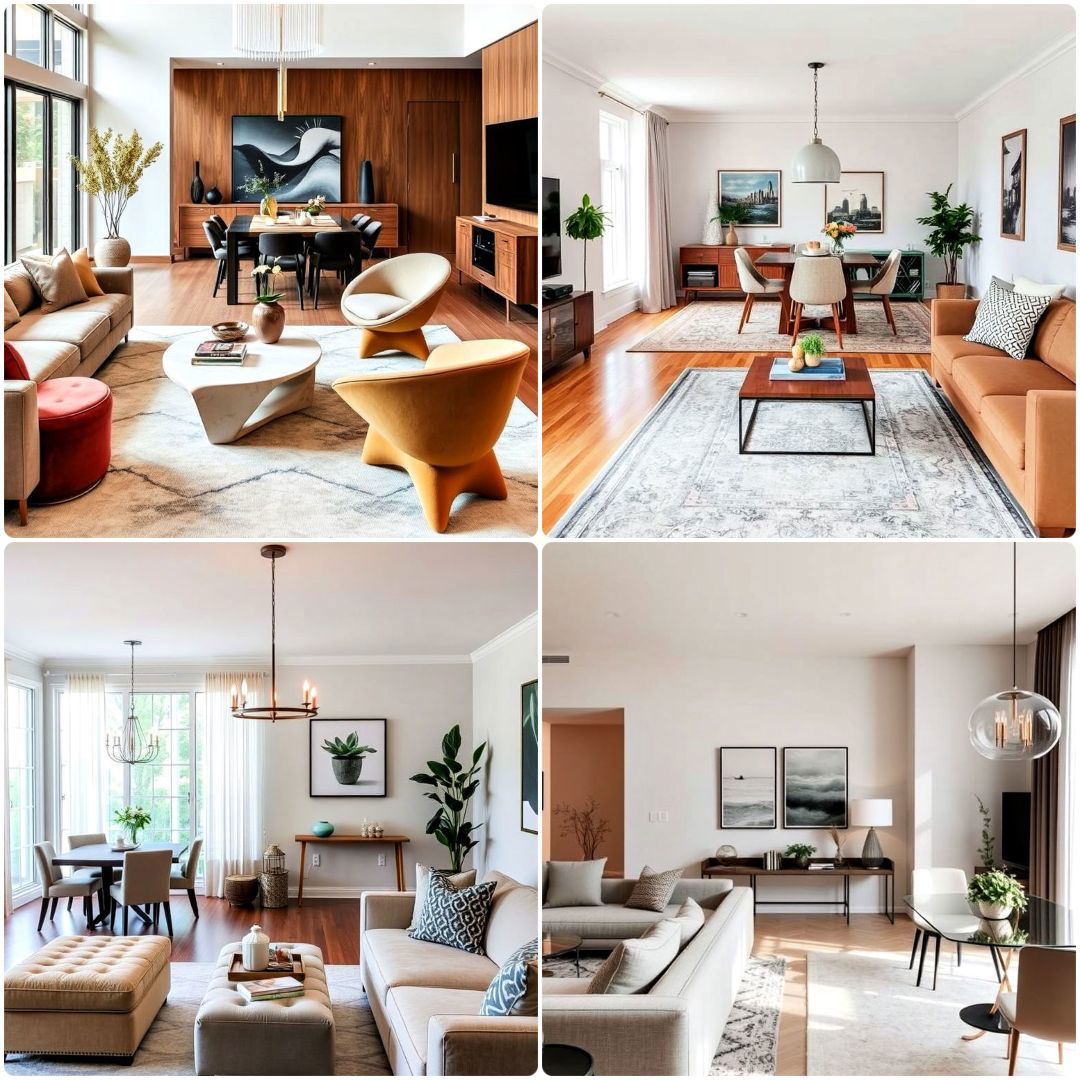
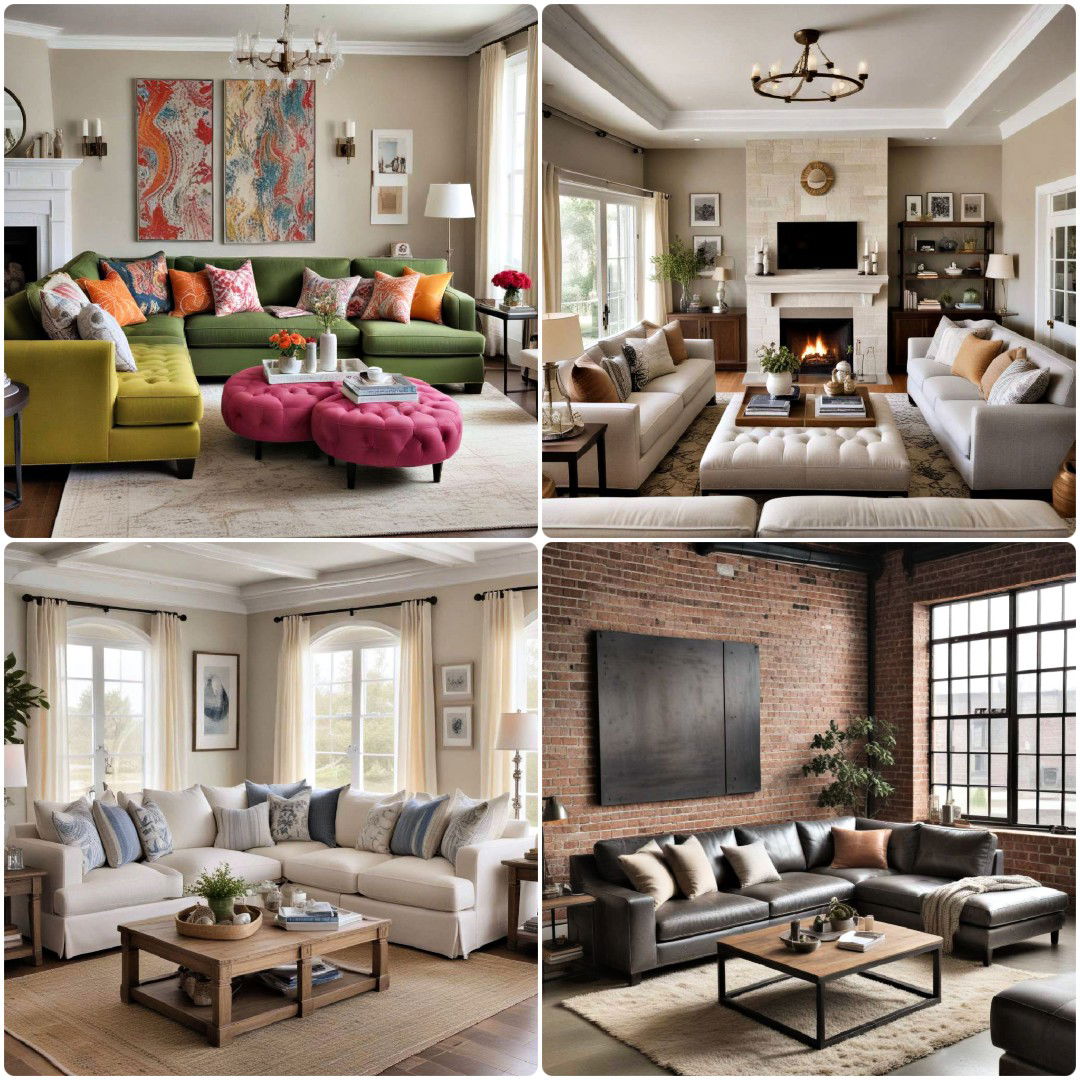
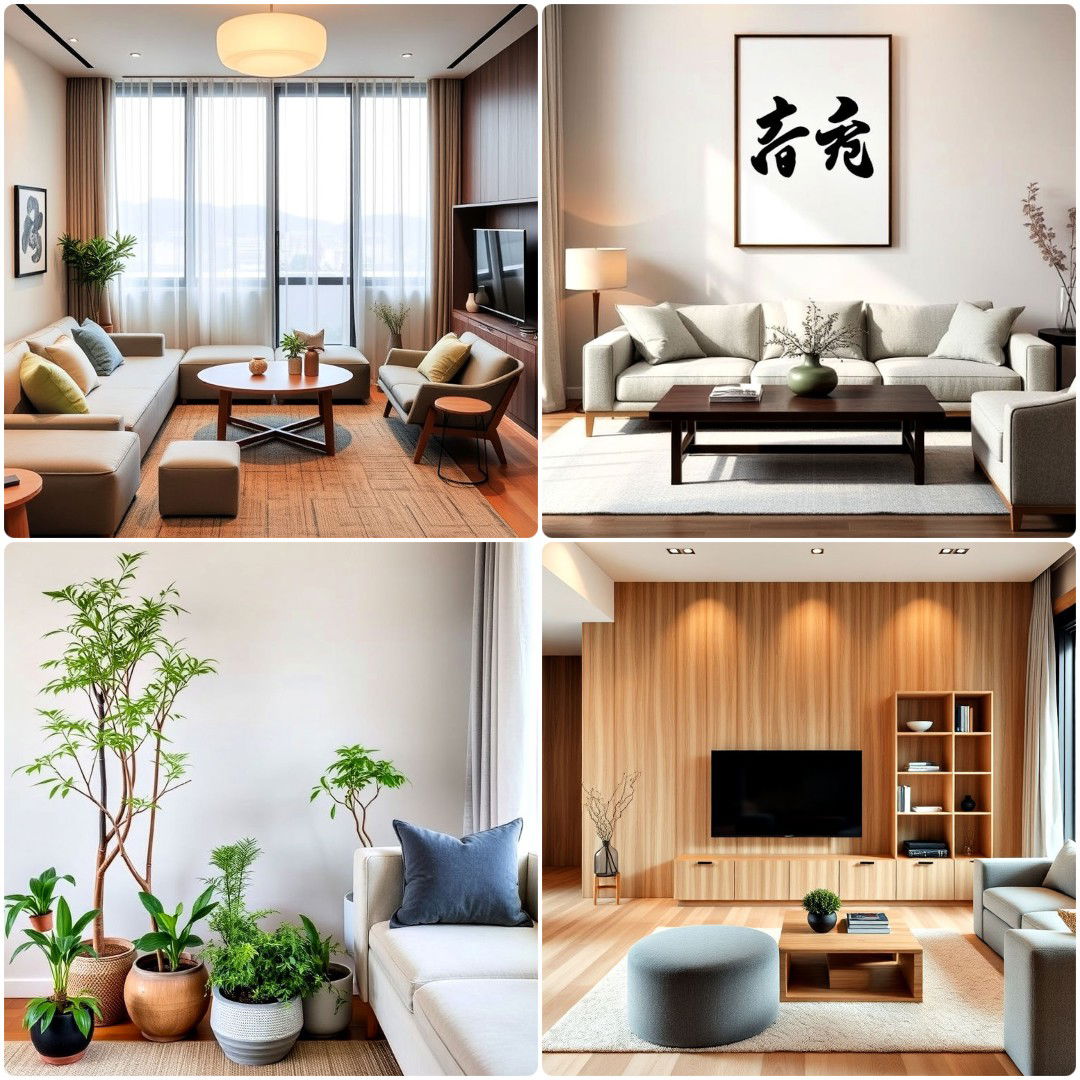
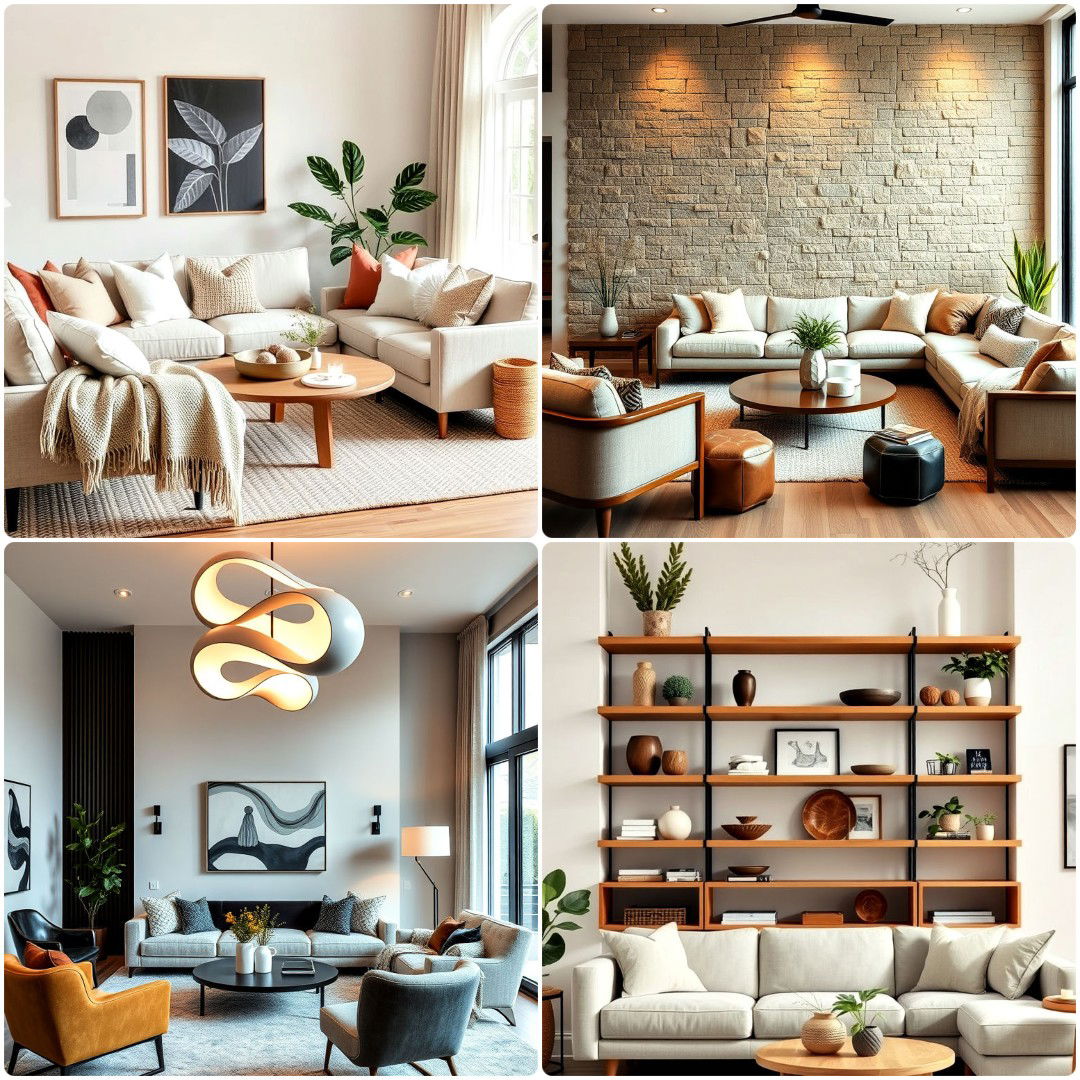
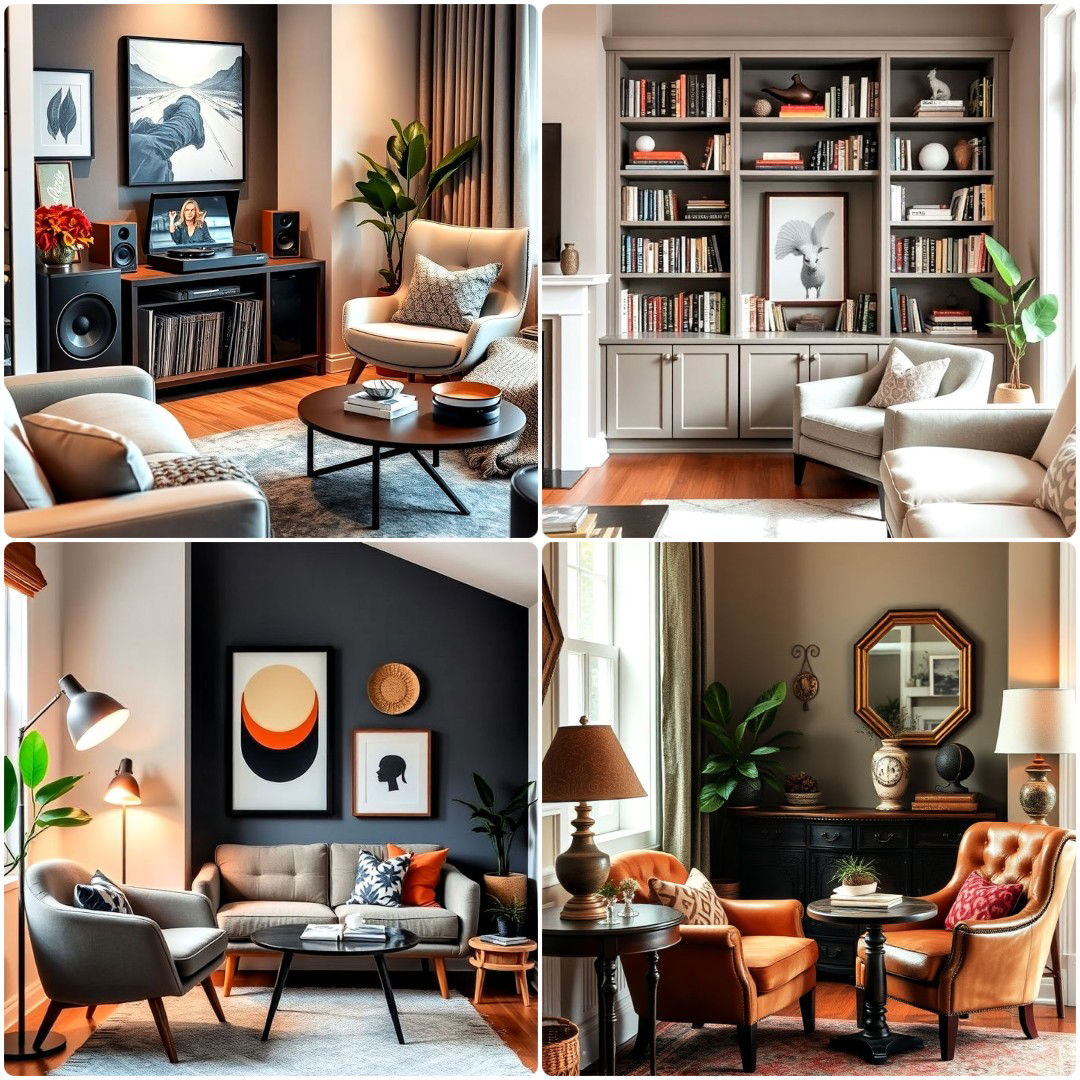
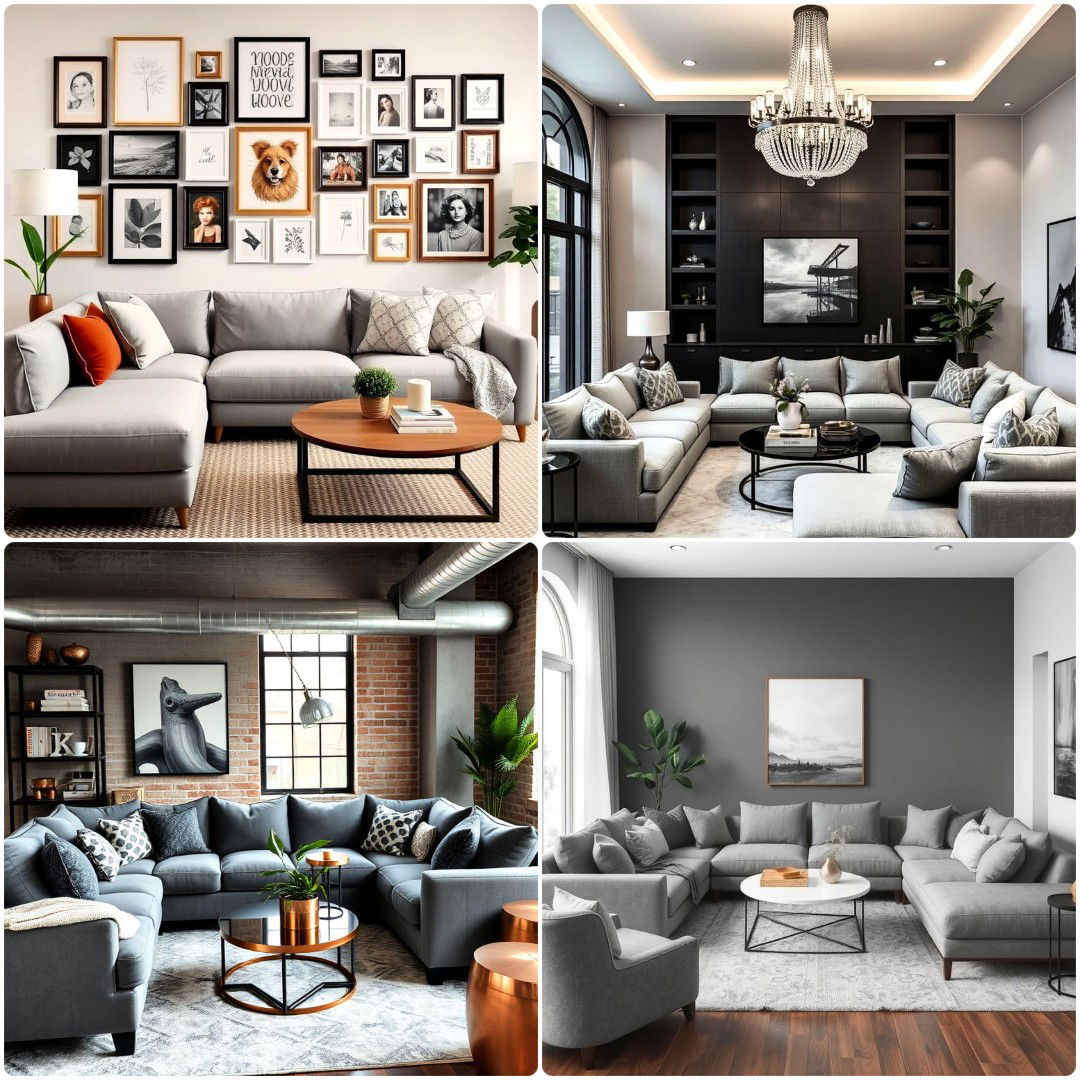
Leave a Reply